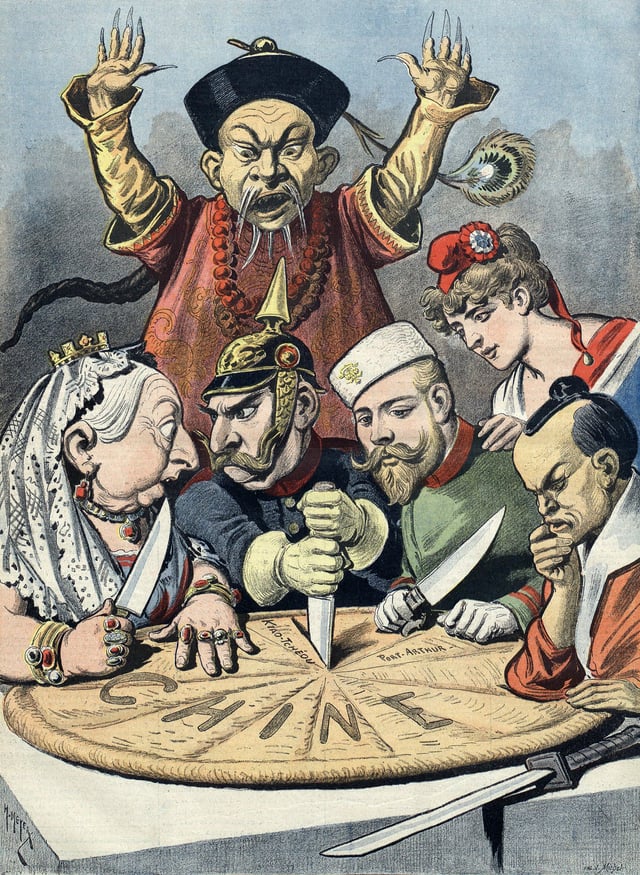Qing dynasty
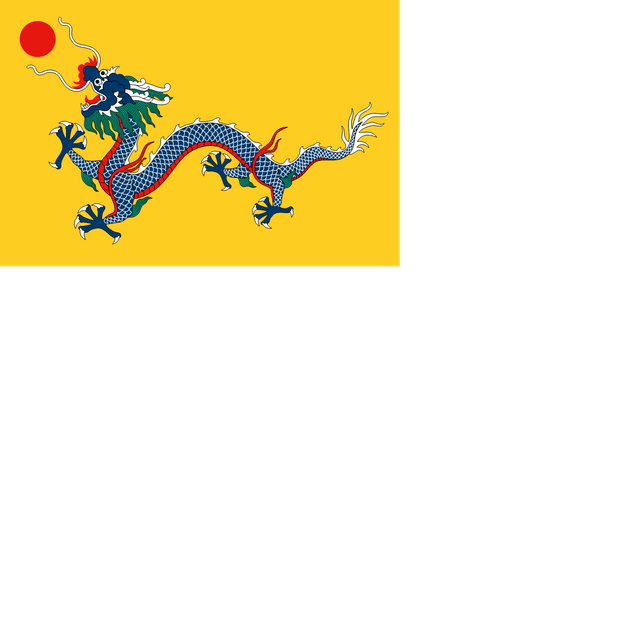
Qing dynasty

Great Qing 大清 ᡩᠠᡳ᠌ᠴᡳᠩ ᡤᡠᡵᡠᠨ | |||||||||||||||||||||||||||||
|---|---|---|---|---|---|---|---|---|---|---|---|---|---|---|---|---|---|---|---|---|---|---|---|---|---|---|---|---|---|
| 1636–1912 | |||||||||||||||||||||||||||||
Anthem:《鞏金甌》 "Gong Jin'ou" (English:"Cup of Solid Gold") (1911–1912) | |||||||||||||||||||||||||||||
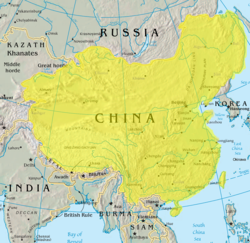 Qing dynasty of China in 1765 | |||||||||||||||||||||||||||||
| Capital | Shengjing (Fengtian Prefecture) (1636–1644)[1] Peking (Shuntian Prefecture) (1644–1912)[2] | ||||||||||||||||||||||||||||
| Common languages | Mandarin, Manchu, Mongolian, Tibetan, Chagatai, [18] numerous regional languages and varieties of Chinese | ||||||||||||||||||||||||||||
| Religion | Heaven worship, Buddhism, Chinese folk religion, Confucianism, Taoism, Islam, Shamanism, Christianity, others | ||||||||||||||||||||||||||||
| Government | Monarchy | ||||||||||||||||||||||||||||
| Emperor | |||||||||||||||||||||||||||||
• 1636–1643 | Hong Taiji (founder) | ||||||||||||||||||||||||||||
• 1644–1661 | Fulin (first in Peking) | ||||||||||||||||||||||||||||
• 1661–1722 | Xuanye (longest) | ||||||||||||||||||||||||||||
• 1723–1735 | Yinzhen | ||||||||||||||||||||||||||||
• 1736–1796 | Hongli | ||||||||||||||||||||||||||||
• 1796–1820 | Yongyan | ||||||||||||||||||||||||||||
• 1821–1850 | Minning | ||||||||||||||||||||||||||||
• 1851–1861 | Yizhu | ||||||||||||||||||||||||||||
• 1862–1875 | Zaichun | ||||||||||||||||||||||||||||
• 1875–1908 | Zaitian | ||||||||||||||||||||||||||||
• 1908–1912 | Puyi (last) | ||||||||||||||||||||||||||||
| Regent | |||||||||||||||||||||||||||||
• 1643–1650 | Dorgon, Prince Rui | ||||||||||||||||||||||||||||
• 1908–1911 | Zaifeng, Prince Chun | ||||||||||||||||||||||||||||
| Prime Minister | |||||||||||||||||||||||||||||
• 1911 | Yikuang, Prince Qing | ||||||||||||||||||||||||||||
• 1911–1912 | Yuan Shikai | ||||||||||||||||||||||||||||
| Historical era | Late modern | ||||||||||||||||||||||||||||
• Later Jin rule | 1616–1636 | ||||||||||||||||||||||||||||
• Dynasty established | April 1636 | ||||||||||||||||||||||||||||
• Conquest of Beijing | 1644 | ||||||||||||||||||||||||||||
| 1687–1759 | |||||||||||||||||||||||||||||
• First Opium War | 1839–1842 | ||||||||||||||||||||||||||||
• Second Opium War | 1856–1860 | ||||||||||||||||||||||||||||
• First Sino-Japanese War | 1 August 1894 – 17 April 1895 | ||||||||||||||||||||||||||||
• Wuchang Uprising | 10 October 1911 | ||||||||||||||||||||||||||||
• Abdication of Puyi | 12 February 1912 | ||||||||||||||||||||||||||||
| Area | |||||||||||||||||||||||||||||
| 1790[19] | 13,100,000 km2(5,100,000 sq mi) | ||||||||||||||||||||||||||||
| 1820[20] | 12,160,000 km2(4,700,000 sq mi) | ||||||||||||||||||||||||||||
| Population | |||||||||||||||||||||||||||||
• 1740 | 140,000,000 | ||||||||||||||||||||||||||||
• 1790 | 301,000,000 | ||||||||||||||||||||||||||||
• 1898 | 395,918,000 | ||||||||||||||||||||||||||||
| Currency | Cash (wén) Tael (liǎng) Paper money | ||||||||||||||||||||||||||||
| |||||||||||||||||||||||||||||
| Qing dynasty | |||||||||||||||||||||||||||||
| Chinese name | |||||||||||||||||||||||||||||
| Chinese | 清朝 | ||||||||||||||||||||||||||||
| |||||||||||||||||||||||||||||
| Dynastic name | |||||||||||||||||||||||||||||
| Chinese | 大清 | ||||||||||||||||||||||||||||
| |||||||||||||||||||||||||||||
| Mongolian name | |||||||||||||||||||||||||||||
| Mongolian Cyrillic | Дайчин улс | ||||||||||||||||||||||||||||
| Mongolian script | ᠳᠠᠶᠢᠴᠢᠩ ᠤᠯᠤᠰ | ||||||||||||||||||||||||||||
| |||||||||||||||||||||||||||||
| Manchu name | |||||||||||||||||||||||||||||
| Manchu script | ᡩᠠᡳ᠌ᠴᡳᠩ ᡤᡠᡵᡠᠨ | ||||||||||||||||||||||||||||
| Abkai | Daiqing gurun | ||||||||||||||||||||||||||||
| Möllendorff | Daicing gurun | ||||||||||||||||||||||||||||
The Qing dynasty, officially the Great Qing ([tɕʰíŋ]), was the last imperial dynasty of China. It was established in 1636, and ruled from 1644 to 1911. It was preceded by the Ming dynasty and succeeded by the Republic of China. The Qing multi-cultural empire lasted for almost three centuries and formed the territorial base for modern China. It was the fifth largest empire in world history. The dynasty was founded by the Manchu Aisin Gioro clan in Manchuria. In the late sixteenth century, Nurhaci, originally a Ming Jianzhou Guard vassal, began organizing "Banners", military-social units that included Manchu, Han, and Mongol elements. Nurhaci formed the Manchu clans into a unified entity and officially proclaimed the Later Jin in 1616. By 1636, his son Hong Taiji began driving Ming forces out of the Liaodong Peninsula and declared a new dynasty, the Qing.
In an unrelated development, peasant rebels led by Li Zicheng conquered the Ming capital, Beijing, in 1644. Rather than serve them, Ming general Wu Sangui made an alliance with the Manchus and opened the Shanhai Pass to the Banner Armies led by the regent Prince Dorgon. He defeated the rebels and seized the capital. Resistance from the Southern Ming and the Revolt of the Three Feudatories led by Wu Sangui delayed the complete Qing conquest of China proper by nearly four decades. The conquest was only completed in 1683 under the Kangxi Emperor (1661–1722). The Ten Great Campaigns of the Qianlong Emperor from the 1750s to the 1790s extended Qing control into Inner Asia. During the peak of the Qing dynasty, the empire ruled over the entirety of today's Mainland China, Hainan, Taiwan, Mongolia, Outer Manchuria and Outer Northwest China. The early Qing rulers maintained their Manchu customs, and while their title was Emperor, they used "Bogd khaan" when dealing with the Mongols and they were patrons of Tibetan Buddhism. They governed using Confucian styles and institutions of bureaucratic government and retained the imperial examinations to recruit Han Chinese to work under or in parallel with Manchus. They also adapted the ideals of the Chinese tributary system in asserting superiority over neighboring territories such as Korea.
The high point of the dynasty came in the late 18th century. By 1800 it steadily deteriorated into poverty and rebellion because of massive internal revolts, heavy foreign pressure, excessive population growth and too-slow adaptation of its governance and its technology. The population rose to some 400 million, but taxes and government revenues were fixed at a low rate, leading to fiscal crisis. Corruption set in, rebels tested government legitimacy, and ruling elites failed to change their mindsets in the face of changes in the world system. Following the Opium Wars, European powers led by Great Britain imposed "unequal treaties", free trade, extraterritoriality and treaty ports under foreign control. The Taiping Rebellion (1850–1864) and the Dungan Revolt (1862–1877) in Central Asia led to the deaths of some 20 million people, most of them due to famines caused by war. In spite of these disasters, in the Tongzhi Restoration of the 1860s, Han Chinese elites rallied to the defense of the Confucian order and the Manchu rulers. The initial gains in the Self-Strengthening Movement were lost in the First Sino-Japanese War of 1895, in which the Qing lost its influence over Korea and the possession of Taiwan. New Armies were organized, but the ambitious Hundred Days' Reform of 1898 was turned back in a coup by the conservative Empress Dowager Cixi (1835–1908), who was in control of the national government (with one interruption) after 1861. When the Scramble for Concessions by foreign powers triggered the violently anti-foreign "Boxers" in 1900, with many foreigners and Christians killed, the foreign powers invaded China. Cixi sided with the Boxers and was decisively defeated by the eight invading powers. They imposed harsh peace terms in the Boxer Protocol,
The government initiated unprecedented fiscal and administrative reforms, including elections, a new legal code, and abolition of the examination system. Sun Yat-sen and other revolutionaries competed with constitutional monarchists such as Kang Youwei and Liang Qichao to transform the Qing Empire into a modern nation. After the deaths of Cixi and the Guangxu Emperor in 1908, the hardline Manchu court alienated reformers and local elites alike by obstructing social reform. The Wuchang Uprising on 11 October 1911, led to the Xinhai Revolution. General Yuan Shikai negotiated the abdication of Puyi, the last emperor, on 12 February 1912.
Great Qing 大清 ᡩᠠᡳ᠌ᠴᡳᠩ ᡤᡠᡵᡠᠨ | |||||||||||||||||||||||||||||
|---|---|---|---|---|---|---|---|---|---|---|---|---|---|---|---|---|---|---|---|---|---|---|---|---|---|---|---|---|---|
| 1636–1912 | |||||||||||||||||||||||||||||
Anthem:《鞏金甌》 "Gong Jin'ou" (English:"Cup of Solid Gold") (1911–1912) | |||||||||||||||||||||||||||||
 Qing dynasty of China in 1765 | |||||||||||||||||||||||||||||
| Capital | Shengjing (Fengtian Prefecture) (1636–1644)[1] Peking (Shuntian Prefecture) (1644–1912)[2] | ||||||||||||||||||||||||||||
| Common languages | Mandarin, Manchu, Mongolian, Tibetan, Chagatai, [18] numerous regional languages and varieties of Chinese | ||||||||||||||||||||||||||||
| Religion | Heaven worship, Buddhism, Chinese folk religion, Confucianism, Taoism, Islam, Shamanism, Christianity, others | ||||||||||||||||||||||||||||
| Government | Monarchy | ||||||||||||||||||||||||||||
| Emperor | |||||||||||||||||||||||||||||
• 1636–1643 | Hong Taiji (founder) | ||||||||||||||||||||||||||||
• 1644–1661 | Fulin (first in Peking) | ||||||||||||||||||||||||||||
• 1661–1722 | Xuanye (longest) | ||||||||||||||||||||||||||||
• 1723–1735 | Yinzhen | ||||||||||||||||||||||||||||
• 1736–1796 | Hongli | ||||||||||||||||||||||||||||
• 1796–1820 | Yongyan | ||||||||||||||||||||||||||||
• 1821–1850 | Minning | ||||||||||||||||||||||||||||
• 1851–1861 | Yizhu | ||||||||||||||||||||||||||||
• 1862–1875 | Zaichun | ||||||||||||||||||||||||||||
• 1875–1908 | Zaitian | ||||||||||||||||||||||||||||
• 1908–1912 | Puyi (last) | ||||||||||||||||||||||||||||
| Regent | |||||||||||||||||||||||||||||
• 1643–1650 | Dorgon, Prince Rui | ||||||||||||||||||||||||||||
• 1908–1911 | Zaifeng, Prince Chun | ||||||||||||||||||||||||||||
| Prime Minister | |||||||||||||||||||||||||||||
• 1911 | Yikuang, Prince Qing | ||||||||||||||||||||||||||||
• 1911–1912 | Yuan Shikai | ||||||||||||||||||||||||||||
| Historical era | Late modern | ||||||||||||||||||||||||||||
• Later Jin rule | 1616–1636 | ||||||||||||||||||||||||||||
• Dynasty established | April 1636 | ||||||||||||||||||||||||||||
• Conquest of Beijing | 1644 | ||||||||||||||||||||||||||||
| 1687–1759 | |||||||||||||||||||||||||||||
• First Opium War | 1839–1842 | ||||||||||||||||||||||||||||
• Second Opium War | 1856–1860 | ||||||||||||||||||||||||||||
• First Sino-Japanese War | 1 August 1894 – 17 April 1895 | ||||||||||||||||||||||||||||
• Wuchang Uprising | 10 October 1911 | ||||||||||||||||||||||||||||
• Abdication of Puyi | 12 February 1912 | ||||||||||||||||||||||||||||
| Area | |||||||||||||||||||||||||||||
| 1790[19] | 13,100,000 km2(5,100,000 sq mi) | ||||||||||||||||||||||||||||
| 1820[20] | 12,160,000 km2(4,700,000 sq mi) | ||||||||||||||||||||||||||||
| Population | |||||||||||||||||||||||||||||
• 1740 | 140,000,000 | ||||||||||||||||||||||||||||
• 1790 | 301,000,000 | ||||||||||||||||||||||||||||
• 1898 | 395,918,000 | ||||||||||||||||||||||||||||
| Currency | Cash (wén) Tael (liǎng) Paper money | ||||||||||||||||||||||||||||
| |||||||||||||||||||||||||||||
| Qing dynasty | |||||||||||||||||||||||||||||
| Chinese name | |||||||||||||||||||||||||||||
| Chinese | 清朝 | ||||||||||||||||||||||||||||
| |||||||||||||||||||||||||||||
| Dynastic name | |||||||||||||||||||||||||||||
| Chinese | 大清 | ||||||||||||||||||||||||||||
| |||||||||||||||||||||||||||||
| Mongolian name | |||||||||||||||||||||||||||||
| Mongolian Cyrillic | Дайчин улс | ||||||||||||||||||||||||||||
| Mongolian script | ᠳᠠᠶᠢᠴᠢᠩ ᠤᠯᠤᠰ | ||||||||||||||||||||||||||||
| |||||||||||||||||||||||||||||
| Manchu name | |||||||||||||||||||||||||||||
| Manchu script | ᡩᠠᡳ᠌ᠴᡳᠩ ᡤᡠᡵᡠᠨ | ||||||||||||||||||||||||||||
| Abkai | Daiqing gurun | ||||||||||||||||||||||||||||
| Möllendorff | Daicing gurun | ||||||||||||||||||||||||||||
Names

The chapter China (中國) in a Chinese, Manchu, and Mongolian languages (trilingual) textbook published during the Qing dynasty; the passage displayed above reads: "Our country China is located in East Asia ... For 5000 years, culture flourished (in the land of China) ... Since we are Chinese, how can we not love China."
Nurhaci declared himself the "Bright Khan" of the Later Jin (lit. "gold") state in honor both of the 12th–13th century Jurchen Jin dynasty and of his Aisin Gioro clan (Aisin being Manchu for the Chinese 金 (jīn, "gold")).[21] His son Hong Taiji renamed the dynasty Great Qing in 1636.[22] There are competing explanations on the meaning of Qīng (lit. "clear" or "pure"). The name may have been selected in reaction to the name of the Ming dynasty (明), which consists of the Chinese characters for "sun" (日) and "moon" (月), both associated with the fire element of the Chinese zodiacal system. The character Qīng (清) is composed of "water" (氵) and "azure" (青), both associated with the water element. This association would justify the Qing conquest as defeat of fire by water. The water imagery of the new name may also have had Buddhist overtones of perspicacity and enlightenment and connections with the Bodhisattva Manjusri.[23] The Manchu name daicing, which sounds like a phonetic rendering of Dà Qīng or Dai Ching, may in fact have been derived from a Mongolian word "ᠳᠠᠢᠢᠴᠢᠨ, дайчин" that means "warrior". Daicing gurun may therefore have meant "warrior state", a pun that was only intelligible to Manchu and Mongol people. In the later part of the dynasty, however, even the Manchus themselves had forgotten this possible meaning.[24]
After conquering "China proper", the Manchus identified their state as "China" (中國, Zhōngguó; "Middle Kingdom"), and referred to it as Dulimbai Gurun in Manchu (Dulimbai means "central" or "middle," gurun means "nation" or "state"). The emperors equated the lands of the Qing state (including present-day Northeast China, Xinjiang, Mongolia, Tibet and other areas) as "China" in both the Chinese and Manchu languages, defining China as a multi-ethnic state, and rejecting the idea that "China" only meant Han areas. The Qing emperors proclaimed that both Han and non-Han peoples were part of "China". They used both "China" and "Qing" to refer to their state in official documents, international treaties (as the Qing was known internationally as "China"[25] or the "Chinese Empire"[26]) and foreign affairs, and "Chinese language" (Manchu: ᡩᡠᠯᡳᠮᠪᠠᡳᡤᡠᡵᡠᠨ ᡳ ᠪᡝᡳᡨᡥᡝ Dulimbai gurun i bithe) included Chinese, Manchu, and Mongol languages, and "Chinese people" (中國之人 Zhōngguó zhī rén; Manchu: Dulimbai gurun i niyalma) referred to all subjects of the empire.[27] In the Chinese-language versions of its treaties and its maps of the world, the Qing government used "Qing" and "China" interchangeably.[28] The dynasty was sometimes referred to as the "Manchu dynasty"[29] or "Pure dynasty" in foreign-language sources.[30]
History
Formation of the Manchu state

An Italian map showing the "Kingdom of the Nüzhen" or the "Jin Tartars", who "have occupied and are at present ruling China", north of Liaodong and Korea, published in 1682. Manchuria is the homeland of the Manchus, the designation introduced in 1635 for the Jurchen
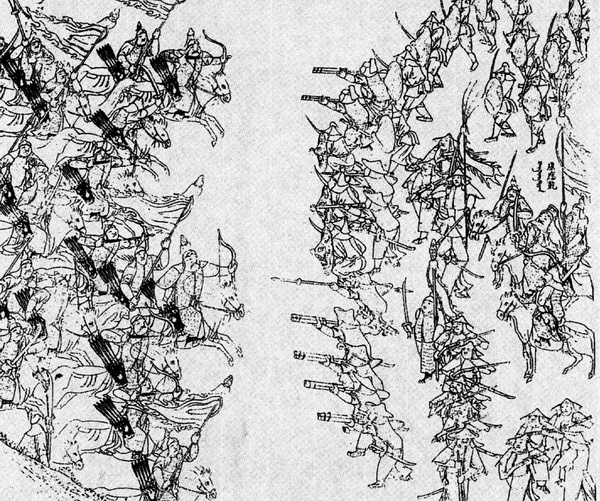
The Manchu cavalry charging Ming infantry in the battle of Sarhu in 1619
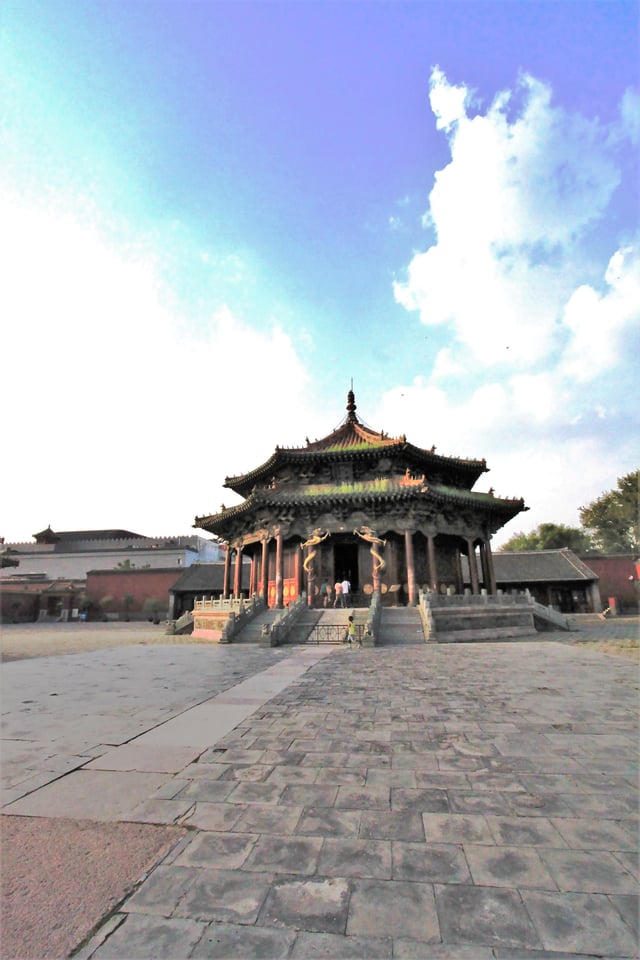
The Mukden Palace
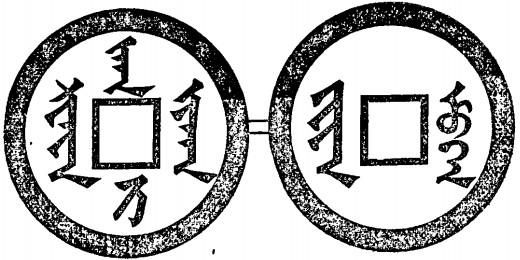
Sura han ni chiha (Coins of Tiancong Khan) in Manchu alphabet
The Qing dynasty was founded not by Han Chinese, who constitute the majority of the Chinese population, but by a sedentary farming people known as the Jurchen, a Tungusic people who lived around the region now comprising the Chinese provinces of Jilin and Heilongjiang.[31] The Manchus are sometimes mistaken for a nomadic people,[32] which they were not.[33][34] What was to become the Manchu state was founded by Nurhaci, the chieftain of a minor Jurchen tribe – the Aisin Gioro – in Jianzhou in the early 17th century. Nurhaci may have spent time in a Chinese household in his youth, and became fluent in Chinese as well as Mongol, and read the Chinese novels Romance of the Three Kingdoms and Water Margin.[35][36][37] Originally a vassal of the Ming emperors, Nurhaci embarked on an intertribal feud in 1582 that escalated into a campaign to unify the nearby tribes. By 1616, he had sufficiently consolidated Jianzhou so as to be able to proclaim himself Khan of the Great Jin in reference to the previous Jurchen dynasty.[38]
Two years later, Nurhaci announced the "Seven Grievances" and openly renounced the sovereignty of Ming overlordship in order to complete the unification of those Jurchen tribes still allied with the Ming emperor. After a series of successful battles, he relocated his capital from Hetu Ala to successively bigger captured Ming cities in Liaodong: first Liaoyang in 1621, then Shenyang (Mukden) in 1625.[38]
When the Jurchens were reorganized by Nurhaci into the Eight Banners, many Manchu clans were artificially created as a group of unrelated people founded a new Manchu clan (mukun) using a geographic origin name such as a toponym for their hala (clan name).[39] The irregularities over Jurchen and Manchu clan origin led to the Qing trying to document and systematize the creation of histories for Manchu clans, including manufacturing an entire legend around the origin of the Aisin Gioro clan by taking mythology from the northeast.[40]
Relocating his court from Jianzhou to Liaodong provided Nurhaci access to more resources; it also brought him in close contact with the Khorchin Mongol domains on the plains of Mongolia. Although by this time the once-united Mongol nation had long since fragmented into individual and hostile tribes, these tribes still presented a serious security threat to the Ming borders. Nurhaci's policy towards the Khorchins was to seek their friendship and cooperation against the Ming, securing his western border from a powerful potential enemy.[41]
Furthermore, the Khorchin proved a useful ally in the war, lending the Jurchens their expertise as cavalry archers. To guarantee this new alliance, Nurhaci initiated a policy of inter-marriages between the Jurchen and Khorchin nobilities, while those who resisted were met with military action. This is a typical example of Nurhaci's initiatives that eventually became official Qing government policy. During most of the Qing period, the Mongols gave military assistance to the Manchus.[41]
Some other important contributions by Nurhaci include ordering the creation of a written Manchu script, based on Mongolian script, after the earlier Jurchen script was forgotten (it had been derived from Khitan and Chinese). Nurhaci also created the civil and military administrative system that eventually evolved into the Eight Banners, the defining element of Manchu identity and the foundation for transforming the loosely knitted Jurchen tribes into a nation.
There were too few ethnic Manchus to conquer China proper, so they gained strength by defeating and absorbing Mongols. More importantly, they added Han Chinese to the Eight Banners.[42] The Manchus had to create an entire "Jiu Han jun" (Old Han Army) due to the massive number of Han Chinese soldiers who were absorbed into the Eight Banners by both capture and defection. Ming artillery was responsible for many victories against the Manchus, so the Manchus established an artillery corps made out of Han Chinese soldiers in 1641, and the swelling of Han Chinese numbers in the Eight Banners led in 1642 to all Eight Han Banners being created.[43] Armies of defected Ming Han Chinese conquered southern China for the Qing.[44]
Han Chinese played a massive role in the Qing conquest of China. Han Chinese Generals who defected to the Manchu were often given women from the Imperial Aisin Gioro family in marriage while the ordinary soldiers who surrendered were often given non-royal Manchu women as wives.[45][46] Jurchen (Manchu) women married Han Chinese in Liaodong.[47] Manchu Aisin Gioro princesses were also given in marriage to Han Chinese officials' sons.[48]
The unbroken series of Nurhaci's military successes ended in January 1626 when he was defeated by Yuan Chonghuan while laying siege to Ningyuan. He died a few months later and was succeeded by his eighth son, Hong Taiji, who emerged after a short political struggle amongst other contenders to be the new Khan. Although Hong Taiji was an experienced leader and the commander of two Banners at the time of his succession, his reign did not start well on the military front. The Jurchens suffered yet another defeat in 1627 at the hands of Yuan Chonghuan. As before, this defeat was, in part, due to the Ming's newly acquired Portuguese cannons.
To redress the technological and numerical disparity, Hong Taiji in 1634 created his own artillery corps, the ujen cooha (Chinese: 重軍) from among his existing Han troops who cast their own cannons in the European design with the help of defector Chinese metallurgists. One of the defining events of Hong Taiji's reign was the official adoption of the name "Manchu" for the united Jurchen people in November 1635. In 1635, the Manchus' Mongol allies were fully incorporated into a separate Banner hierarchy under direct Manchu command. Hong Taiji conquered the territory north of Shanhai Pass by Ming dynasty and Ligdan Khan in Inner Mongolia. In April 1636, Mongol nobility of Inner Mongolia, Manchu nobility and the Han mandarin held the Kurultai in Shenyang, recommended khan of Later Jin to be the emperor of Great Qing empire. One of the Yuan Dynasty's jade seal has also dedicated to the emperor (Bogd Setsen Khan) by nobility.[49][50] When he was said to be presented with the imperial seal of the Yuan dynasty after the defeat of the last Khagan of the Mongols, Hong Taiji renamed his state from "Great Jin" to "Great Qing" and elevated his position from Khan to Emperor, suggesting imperial ambitions beyond unifying the Manchu territories. Hong Taiji then proceeded in 1636 to invade Korea again.
The change of the name from Jurchen to Manchu was made to hide the fact that the ancestors of the Manchus, the Jianzhou Jurchens, were ruled by the Chinese.[51] The Qing dynasty carefully hid the original editions of the books of "Qing Taizu Wu Huangdi Shilu" and the "Manzhou Shilu Tu" (Taizu Shilu Tu) in the Qing palace, forbidden from public view because they showed that the Manchu Aisin Gioro family had been ruled by the Ming dynasty and followed many Manchu customs that seemed "uncivilized" in later eyes.[52] In the Ming period, the Koreans of Joseon referred to the Jurchen inhabited lands north of the Korean peninsula, above the rivers Yalu and Tumen to be part of Ming China, as the "superior country" (sangguk) which they called Ming China.[53] The Qing deliberately excluded references and information that showed the Jurchens (Manchus) as subservient to the Ming dynasty, from the History of Ming to hide their former subservient relationship to the Ming. The Veritable Records of Ming were not used to source content on Jurchens during Ming rule in the History of Ming because of this.[54]
This was followed by the creation of the first two Han Banners in 1637 (increasing to eight in 1642). Together these military reforms enabled Hong Taiji to resoundingly defeat Ming forces in a series of battles from 1640 to 1642 for the territories of Songshan and Jinzhou. This final victory resulted in the surrender of many of the Ming dynasty's most battle-hardened troops, the death of Yuan Chonghuan at the hands of the Chongzhen Emperor (who thought Yuan had betrayed him), and the complete and permanent withdrawal of the remaining Ming forces north of the Great Wall.
Meanwhile, Hong Taiji set up a rudimentary bureaucratic system based on the Ming model. He established six boards or executive level ministries in 1631 to oversee finance, personnel, rites, military, punishments, and public works. However, these administrative organs had very little role initially, and it was not until the eve of completing the conquest ten years later that they fulfilled their government roles.[57]
Hong Taiji's bureaucracy was staffed with many Han Chinese, including many newly surrendered Ming officials. The Manchus' continued dominance was ensured by an ethnic quota for top bureaucratic appointments. Hong Taiji's reign also saw a fundamental change of policy towards his Han Chinese subjects. Nurhaci had treated Han in Liaodong differently according to how much grain they had: those with less than 5 to 7 sin were treated badly, while those with more than that amount were rewarded with property. Due to a revolt by Han in Liaodong in 1623, Nurhaci, who previously gave concessions to conquered Han subjects in Liaodong, turned against them and ordered that they no longer be trusted. He enacted discriminatory policies and killings against them, while ordering that Han who assimilated to the Jurchen (in Jilin) before 1619 be treated equally, as Jurchens were, and not like the conquered Han in Liaodong. Hong Taiji recognized that the Manchus needed to attract Han Chinese, explaining to reluctant Manchus why he needed to treat the Ming defector General Hong Chengchou leniently.[58] Hong Taiji instead incorporated them into the Jurchen "nation" as full (if not first-class) citizens, obligated to provide military service. By 1648, less than one-sixth of the bannermen were of Manchu ancestry.[59] This change of policy not only increased Hong Taiji's manpower and reduced his military dependence on banners not under his personal control, it also greatly encouraged other Han Chinese subjects of the Ming dynasty to surrender and accept Jurchen rule when they were defeated militarily. Through these and other measures Hong Taiji was able to centralize power unto the office of the Khan, which in the long run prevented the Jurchen federation from fragmenting after his death.
Claiming the Mandate of Heaven

Dorgon (1612–1650)
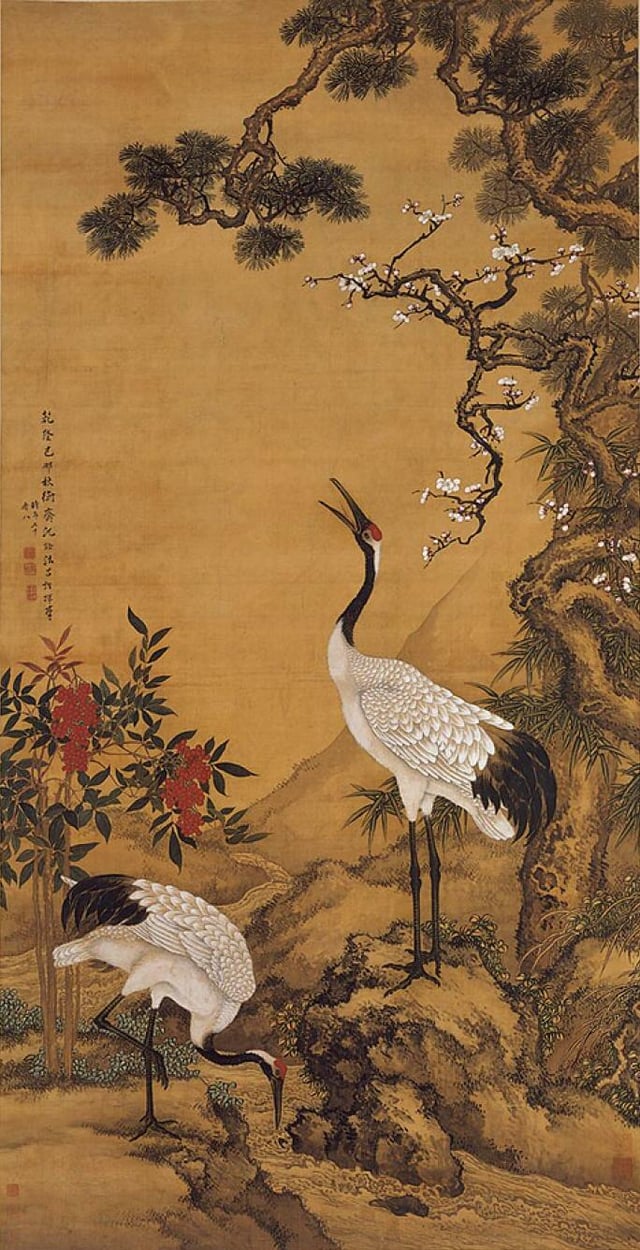
Pine, Plum and Cranes, 1759, by Shen Quan (1682–1760). Hanging scroll, ink and colour on silk. The Palace Museum, Beijing.
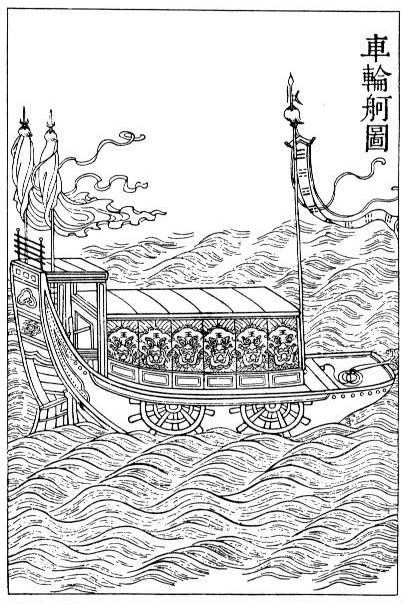
A Chinese paddle-wheel driven ship from a Qing encyclopedia published in 1726
Hong Taiji died suddenly in September 1643. As the Jurchens had traditionally "elected" their leader through a council of nobles, the Qing state did not have a clear succession system. The leading contenders for power were Hong Taiji's oldest son Hooge and Hong Taiji's half brother Dorgon. A compromise installed Hong Taiji's five-year-old son, Fulin, as the Shunzhi Emperor, with Dorgon as regent and de facto leader of the Manchu nation.
Meanwhile, Ming government officials fought against each other, against fiscal collapse, and against a series of peasant rebellions. They were unable to capitalise on the Manchu succession dispute and the presence of a minor as emperor. In April 1644, the capital, Beijing, was sacked by a coalition of rebel forces led by Li Zicheng, a former minor Ming official, who established a short-lived Shun dynasty. The last Ming ruler, the Chongzhen Emperor, committed suicide when the city fell to the rebels, marking the official end of the dynasty.
Li Zicheng then led a collection of rebel forces numbering some 200,000 [60] to confront Wu Sangui, the general commanding the Ming garrison at Shanhai Pass, a key pass of the Great Wall, located fifty miles northeast of Beijing, which defended the capital. Wu Sangui, caught between a rebel army twice his size and an enemy he had fought for years, cast his lot with the foreign but familiar Manchus. Wu Sangui may have been influenced by Li Zicheng's mistreatment of wealthy and cultured officials, including Li's own family; it was said that Li took Wu's concubine Chen Yuanyuan for himself. Wu and Dorgon allied in the name of avenging the death of the Chongzhen Emperor. Together, the two former enemies met and defeated Li Zicheng's rebel forces in battle on May 27, 1644.[61]
The newly allied armies captured Beijing on 6 June. The Shunzhi Emperor was invested as the "Son of Heaven" on 30 October. The Manchus, who had positioned themselves as political heirs to the Ming emperor by defeating Li Zicheng, completed the symbolic transition by holding a formal funeral for the Chongzhen Emperor. However, conquering the rest of China Proper took another seventeen years of battling Ming loyalists, pretenders and rebels. The last Ming pretender, Prince Gui, sought refuge with the King of Burma, Pindale Min, but was turned over to a Qing expeditionary army commanded by Wu Sangui, who had him brought back to Yunnan province and executed in early 1662.
The Qing had taken shrewd advantage of Ming civilian government discrimination against the military and encouraged the Ming military to defect by spreading the message that the Manchus valued their skills.[62] Banners made up of Han Chinese who defected before 1644 were classed among the Eight Banners, giving them social and legal privileges in addition to being acculturated to Manchu traditions. Han defectors swelled the ranks of the Eight Banners so greatly that ethnic Manchus became a minority—only 16% in 1648, with Han Bannermen dominating at 75% and Mongol Bannermen making up the rest.[63] Gunpowder weapons like muskets and artillery were wielded by the Chinese Banners.[64] Normally, Han Chinese defector troops were deployed as the vanguard, while Manchu Bannermen acted as reserve forces or in the rear and were used predominantly for quick strikes with maximum impact, so as to minimize ethnic Manchu losses.[65]
This multi-ethnic force conquered China for the Qing.[66] The three Liaodong Han Bannermen officers who played key roles in the conquest of southern China were Shang Kexi, Geng Zhongming, and Kong Youde, who governed southern China autonomously as viceroys for the Qing after the conquest.[67] Han Chinese Bannermen made up the majority of governors in the early Qing, and they governed and administered China after the conquest, stabilizing Qing rule.[68] Han Bannermen dominated the post of governor-general in the time of the Shunzhi and Kangxi Emperors, and also the post of governor, largely excluding ordinary Han civilians from these posts.[69]
To promote ethnic harmony, a 1648 decree allowed Han Chinese civilian men to marry Manchu women from the Banners with the permission of the Board of Revenue if they were registered daughters of officials or commoners, or with the permission of their banner company captain if they were unregistered commoners. Later in the dynasty the policies allowing intermarriage were done away with.[70]
The southern cadet branch of Confucius' descendants who held the title Wujing boshi (Doctor of the Five Classics) and 65th generation descendant in the northern branch who held the title Duke Yansheng both had their titles confirmed by the Shunzhi Emperor upon the Qing entry into Beijing on 31 October.[71] The Kong's title of Duke was maintained in later reigns.[72]
The first seven years of the Shunzhi Emperor's reign were dominated by the regent prince Dorgon. Because of his own political insecurity, Dorgon followed Hong Taiji's example by ruling in the name of the emperor at the expense of rival Manchu princes, many of whom he demoted or imprisoned under one pretext or another. Although the period of his regency was relatively short, Dorgon's precedents and example cast a long shadow over the dynasty.
First, the Manchus had entered "South of the Wall" because Dorgon responded decisively to Wu Sangui's appeal. Then, after capturing Beijing, instead of sacking the city as the rebels had done, Dorgon insisted, over the protests of other Manchu princes, on making it the dynastic capital and reappointing most Ming officials. Choosing Beijing as the capital had not been a straightforward decision, since no major Chinese dynasty had directly taken over its immediate predecessor's capital. Keeping the Ming capital and bureaucracy intact helped quickly stabilize the regime and sped up the conquest of the rest of the country. Dorgon then drastically reduced the influence of the eunuchs, a major force in the Ming bureaucracy, and directed Manchu women not to bind their feet in the Chinese style.[73]
However, not all of Dorgon's policies were equally popular or as easy to implement. The controversial July 1645 edict (the "haircutting order") forced adult Han Chinese men to shave the front of their heads and comb the remaining hair into the queue hairstyle which was worn by Manchu men, on pain of death.[74] The popular description of the order was: "To keep the hair, you lose the head; To keep your head, you cut the hair."[73] To the Manchus, this policy was a test of loyalty and an aid in distinguishing friend from foe. For the Han Chinese, however, it was a humiliating reminder of Qing authority that challenged traditional Confucian values. The Classic of Filial Piety (Xiaojing) held that "a person's body and hair, being gifts from one's parents, are not to be damaged". Under the Ming dynasty, adult men did not cut their hair but instead wore it in the form of a top-knot.[75] The order triggered strong resistance to Qing rule in Jiangnan[76] and massive killing of Han Chinese. It was Han Chinese defectors who carried out massacres against people refusing to wear the queue. Li Chengdong, a Han Chinese general who had served the Ming but surrendered to the Qing,[77] ordered his Han troops to carry out three separate massacres in the city of Jiading within a month, resulting in tens of thousands of deaths. At the end of the third massacre, there was hardly a living person left in this city.[78] Jiangyin also held out against about 10,000 Han Chinese Qing troops for 83 days. When the city wall was finally breached on 9 October 1645, the Han Chinese Qing army led by the Han Chinese Ming defector Liu Liangzuo (劉良佐), who had been ordered to "fill the city with corpses before you sheathe your swords", massacred the entire population, killing between 74,000 and 100,000 people.[79] The queue was the only aspect of Manchu culture which the Qing forced on the common Han population. The Qing required people serving as officials to wear Manchu clothing, but allowed non-official Han civilians to continue wearing Hanfu (Han clothing).
On 31 December 1650, Dorgon suddenly died during a hunting expedition, marking the official start of the Shunzhi Emperor's personal rule. Because the emperor was only 12 years old at that time, most decisions were made on his behalf by his mother, Empress Dowager Xiaozhuang, who turned out to be a skilled political operator.
Although his support had been essential to Shunzhi's ascent, Dorgon had centralised so much power in his hands as to become a direct threat to the throne. So much so that upon his death he was bestowed the extraordinary posthumous title of Emperor Yi (Chinese: 義皇帝), the only instance in Qing history in which a Manchu "prince of the blood" (Chinese: 親王) was so honored. Two months into Shunzhi's personal rule, however, Dorgon was not only stripped of his titles, but his corpse was disinterred and mutilated.[3] to atone for multiple "crimes", one of which was persecuting to death Shunzhi's agnate eldest brother, Hooge. More importantly, Dorgon's symbolic fall from grace also led to the purge of his family and associates at court, thus reverting power back to the person of the emperor. After a promising start, Shunzhi's reign was cut short by his early death in 1661 at the age of twenty-four from smallpox. He was succeeded by his third son Xuanye, who reigned as the Kangxi Emperor.
The Manchus sent Han Bannermen to fight against Koxinga's Ming loyalists in Fujian.[80] They removed the population from coastal areas in order to deprive Koxinga's Ming loyalists of resources. This led to a misunderstanding that Manchus were "afraid of water". Han Bannermen carried out the fighting and killing, casting doubt on the claim that fear of the water led to the coastal evacuation and ban on maritime activities.[81] Even though a poem refers to the soldiers carrying out massacres in Fujian as "barbarians", both Han Green Standard Army and Han Bannermen were involved and carried out the worst slaughter.[82] 400,000 Green Standard Army soldiers were used against the Three Feudatories in addition to the 200,000 Bannermen.[83]
Kangxi Emperor's reign and consolidation
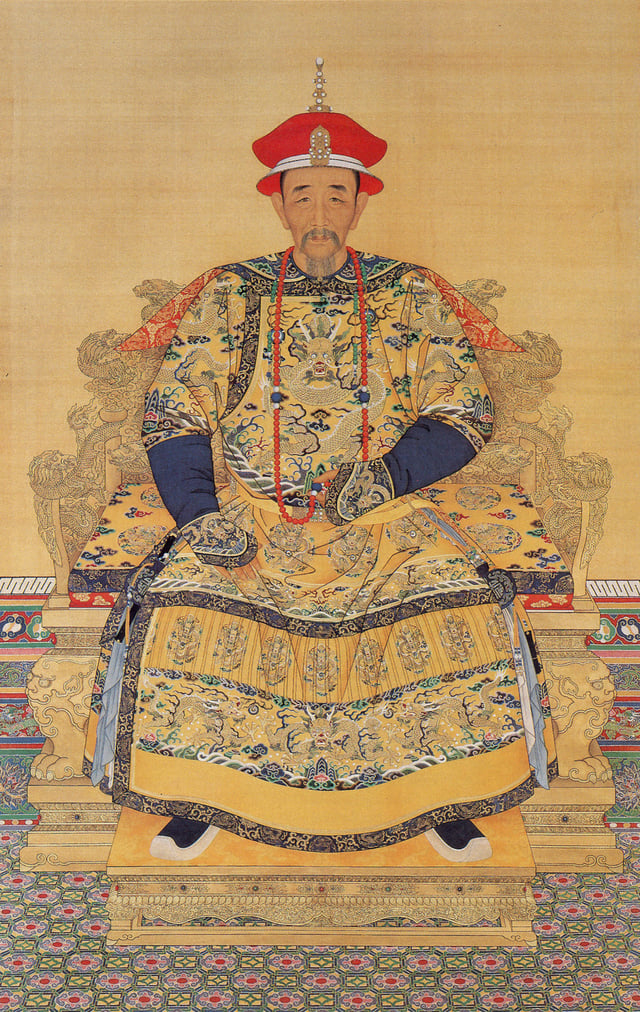
The Kangxi Emperor (r. 1662–1722)
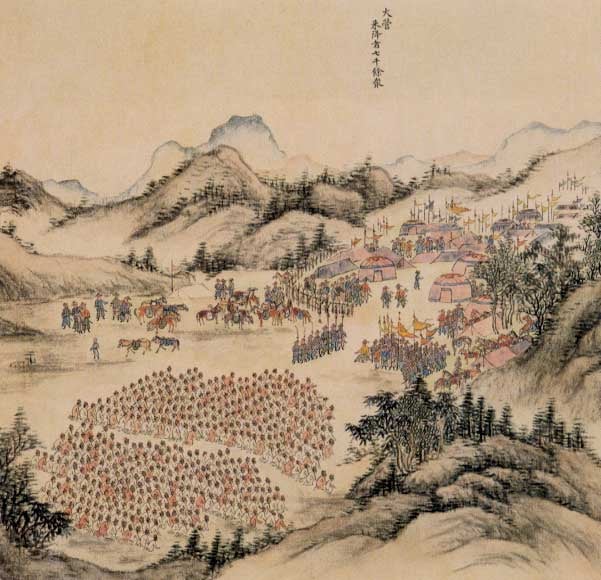
Camp of the Manchu army in Khalkha in 1688
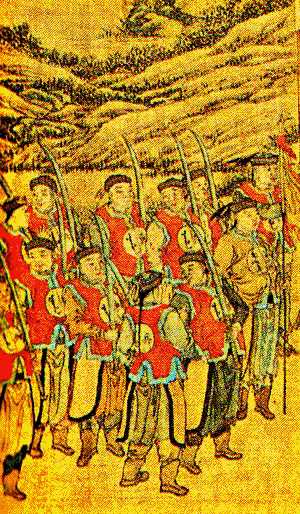
Banners of 17th century
The sixty-one year reign of the Kangxi Emperor was the longest of any Chinese emperor. Kangxi's reign is also celebrated as the beginning of an era known as the "High Qing", during which the dynasty reached the zenith of its social, economic and military power. Kangxi's long reign started when he was eight years old upon the untimely demise of his father. To prevent a repeat of Dorgon's dictatorial monopolizing of power during the regency, the Shunzhi Emperor, on his deathbed, hastily appointed four senior cabinet ministers to govern on behalf of his young son. The four ministers – Sonin, Ebilun, Suksaha, and Oboi – were chosen for their long service, but also to counteract each other's influences. Most important, the four were not closely related to the imperial family and laid no claim to the throne. However, as time passed, through chance and machination, Oboi, the most junior of the four, achieved such political dominance as to be a potential threat. Even though Oboi's loyalty was never an issue, his personal arrogance and political conservatism led him into an escalating conflict with the young emperor. In 1669 Kangxi, through trickery, disarmed and imprisoned Oboi – a significant victory for a fifteen-year-old emperor over a wily politician and experienced commander.
The early Manchu rulers established two foundations of legitimacy that help to explain the stability of their dynasty. The first was the bureaucratic institutions and the neo-Confucian culture that they adopted from earlier dynasties.[84] Manchu rulers and Han Chinese scholar-official elites gradually came to terms with each other. The examination system offered a path for ethnic Han to become officials. Imperial patronage of Kangxi Dictionary demonstrated respect for Confucian learning, while the Sacred Edict of 1670 effectively extolled Confucian family values. His attempts to discourage Chinese women from foot binding, however, were unsuccessful.
The second major source of stability was the Central Asian aspect of their Manchu identity, which allowed them to appeal to Mongol, Tibetan and Uighur constituents. The ways of the Qing legitimization were different for the Chinese, Mongolian and Tibetan peoples. This contradicted traditional Chinese worldview requiring acculturation of "barbarians". Qing emperors, on the contrary, sought to prevent this in regard to Mongols and Tibetans.[85] The Qing used the title of Emperor (Huangdi) in Chinese, while among Mongols the Qing monarch was referred to as Bogda khan (wise Khan), and referred to as Gong Ma in Tibet.[86] The Qianlong Emperor propagated the image of himself as a Buddhist sage ruler, a patron of Tibetan Buddhism.[87] In the Manchu language, the Qing monarch was alternately referred to as either Huwangdi (Emperor) or Khan with no special distinction between the two usages. The Kangxi Emperor also welcomed to his court Jesuit missionaries, who had first come to China under the Ming. Missionaries including Tomás Pereira, Martino Martini, Johann Adam Schall von Bell, Ferdinand Verbiest and Antoine Thomas held significant positions as military weapons experts, mathematicians, cartographers, astronomers and advisers to the emperor. The relationship of trust was however lost in the later Chinese Rites controversy.
Yet controlling the "Mandate of Heaven" was a daunting task. The vastness of China's territory meant that there were only enough banner troops to garrison key cities forming the backbone of a defense network that relied heavily on surrendered Ming soldiers. In addition, three surrendered Ming generals were singled out for their contributions to the establishment of the Qing dynasty, ennobled as feudal princes (藩王), and given governorships over vast territories in Southern China. The chief of these was Wu Sangui, who was given the provinces of Yunnan and Guizhou, while generals Shang Kexi and Geng Jingzhong were given Guangdong and Fujian provinces respectively.
As the years went by, the three feudal lords and their extensive territories became increasingly autonomous. Finally, in 1673, Shang Kexi petitioned Kangxi for permission to retire to his hometown in Liaodong province and nominated his son as his successor. The young emperor granted his retirement, but denied the heredity of his fief. In reaction, the two other generals decided to petition for their own retirements to test Kangxi's resolve, thinking that he would not risk offending them. The move backfired as the young emperor called their bluff by accepting their requests and ordering that all three fiefdoms to be reverted to the crown.
Faced with the stripping of their powers, Wu Sangui, later joined by Geng Zhongming and by Shang Kexi's son Shang Zhixin, felt they had no choice but to revolt. The ensuing Revolt of the Three Feudatories lasted for eight years. Wu attempted, ultimately in vain, to fire the embers of south China Ming loyalty by restoring Ming customs, ordering that the resented queues be cut, and declaring himself emperor of a new dynasty. At the peak of the rebels' fortunes, they extended their control as far north as the Yangtze River, nearly establishing a divided China. Wu then hesitated to go further north, not being able to coordinate strategy with his allies, and Kangxi was able to unify his forces for a counterattack led by a new generation of Manchu generals. By 1681, the Qing government had established control over a ravaged southern China which took several decades to recover.[88]
Manchu Generals and Bannermen were initially put to shame by the better performance of the Han Chinese Green Standard Army. Kangxi accordingly assigned generals Sun Sike, Wang Jinbao, and Zhao Liangdong to crush the rebels, since he thought that Han Chinese were superior to Bannermen at battling other Han people.[89] Similarly, in north-western China against Wang Fuchen, the Qing used Han Chinese Green Standard Army soldiers and Han Chinese generals as the primary military forces. This choice was due to the rocky terrain, which favoured infantry troops over cavalry, to the desire to keep Bannermen in reserve, and, again, to the belief that Han troops were better at fighting other Han people. These Han generals achieved victory over the rebels.[90] Also due to the mountainous terrain, Sichuan and southern Shaanxi were retaken by the Green Standard Army in 1680, with Manchus participating only in logistics and provisions.[91] 400,000 Green Standard Army soldiers and 150,000 Bannermen served on the Qing side during the war.[91] 213 Han Chinese Banner companies, and 527 companies of Mongol and Manchu Banners were mobilized by the Qing during the revolt.[64] 400,000 Green Standard Army soldiers were used against the Three Feudatories besides 200,000 Bannermen.[92]
The Qing forces were crushed by Wu from 1673–1674.[93] The Qing had the support of the majority of Han Chinese soldiers and Han elite against the Three Feudatories, since they refused to join Wu Sangui in the revolt, while the Eight Banners and Manchu officers fared poorly against Wu Sangui, so the Qing responded with using a massive army of more than 900,000 Han Chinese (non-Banner) instead of the Eight Banners, to fight and crush the Three Feudatories.[94] Wu Sangui's forces were crushed by the Green Standard Army, made out of defected Ming soldiers.[95]
To extend and consolidate the dynasty's control in Central Asia, the Kangxi Emperor personally led a series of military campaigns against the Dzungars in Outer Mongolia. The Kangxi Emperor was able to successfully expel Galdan's invading forces from these regions, which were then incorporated into the empire. Galdan was eventually killed in the Dzungar–Qing War.[96] In 1683, Qing forces received the surrender of Formosa (Taiwan) from Zheng Keshuang, grandson of Koxinga, who had conquered Taiwan from the Dutch colonists as a base against the Qing. Zheng Keshuang was awarded the title "Duke Haicheng" (海澄公) and was inducted into the Han Chinese Plain Red Banner of the Eight Banners when he moved to Beijing. Several Ming princes had accompanied Koxinga to Taiwan in 1661–1662, including the Prince of Ningjing Zhu Shugui and Prince Zhu Honghuan (朱弘桓), son of Zhu Yihai, where they lived in the Kingdom of Tungning. The Qing sent the 17 Ming princes still living on Taiwan in 1683 back to mainland China where they spent the rest of their lives in exile since their lives were spared from execution.[97] Winning Taiwan freed Kangxi's forces for series of battles over Albazin, the far eastern outpost of the Tsardom of Russia. Zheng's former soldiers on Taiwan like the rattan shield troops were also inducted into the Eight Banners and used by the Qing against Russian Cossacks at Albazin. The 1689 Treaty of Nerchinsk was China's first formal treaty with a European power and kept the border peaceful for the better part of two centuries. After Galdan's death, his followers, as adherents to Tibetan Buddhism, attempted to control the choice of the next Dalai Lama. Kangxi dispatched two armies to Lhasa, the capital of Tibet, and installed a Dalai Lama sympathetic to the Qing.[98]
By the end of the 17th century, China was at its greatest height of confidence and political control since the Ming dynasty.
Reigns of the Yongzheng and Qianlong emperors
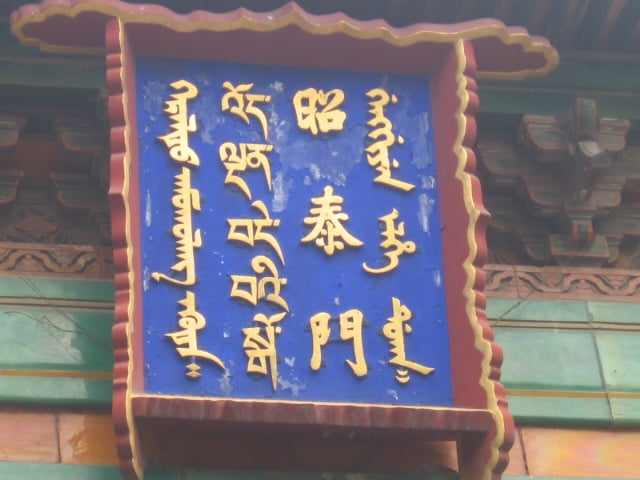
A sign in Mongolian, Tibetan, Chinese and Manchu at the Yonghe monastery in Beijing
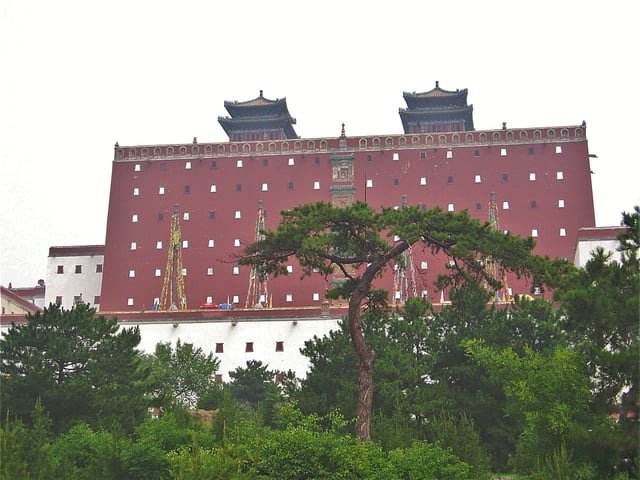
The Putuo Zongcheng Temple of Chengde, built in the 18th century during the reign of the Qianlong Emperor

Campaign against the Dzungars and the Qing conquest of Xinjiang between 1755 and 1758
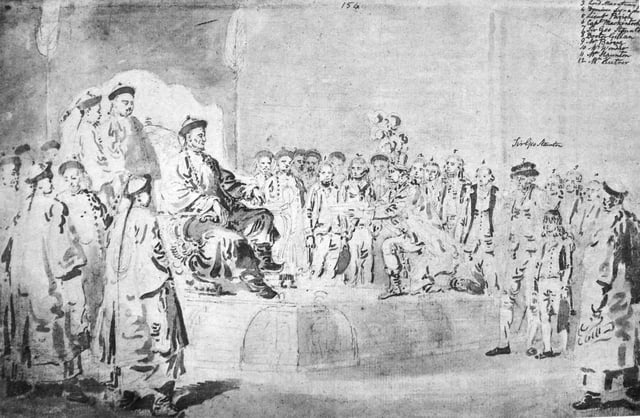
Lord Macartney saluting the Qianlong Emperor
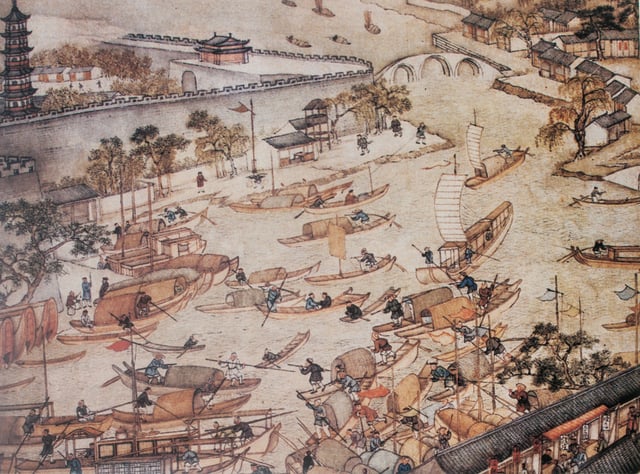
Commerce on the water, Prosperous Suzhou by Xu Yang, 1759
The reigns of the Yongzheng Emperor (r. 1723–1735) and his son, the Qianlong Emperor (r. 1735–1796), marked the height of Qing power. During this period, the Qing Empire ruled over 13 million square kilometers of territory. Yet, as the historian Jonathan Spence puts it, the empire by the end of the Qianlong reign was "like the sun at midday". In the midst of "many glories", he writes, "signs of decay and even collapse were becoming apparent".[99]
After the death of the Kangxi Emperor in the winter of 1722, his fourth son, Prince Yong (雍親王), became the Yongzheng Emperor. In the later years of Kangxi's reign, Yongzheng and his brothers had fought, and there were rumours that he had usurped the throne – most of the rumours held that Yongzheng's brother Yingzhen (Kangxi's 14th son) was the real successor of the Kangxi Emperor, and that Yongzheng and his confidant Keduo Long had tampered with the Kangxi's testament on the night when Kangxi died, though there was little evidence for these charges. In fact, his father had trusted him with delicate political issues and discussed state policy with him. When Yongzheng came to power at the age of 45, he felt a sense of urgency about the problems that had accumulated in his father's later years, and he did not need instruction on how to exercise power.[100] In the words of one recent historian, he was "severe, suspicious, and jealous, but extremely capable and resourceful",[101] and in the words of another, he turned out to be an "early modern state-maker of the first order".[102]
Yongzheng moved rapidly. First, he promoted Confucian orthodoxy and reversed what he saw as his father's laxness by cracking down on unorthodox sects and by decapitating an anti-Manchu writer his father had pardoned. In 1723 he outlawed Christianity and expelled Christian missionaries, though some were allowed to remain in the capital.[103] Next, he moved to control the government. He expanded his father's system of Palace Memorials, which brought frank and detailed reports on local conditions directly to the throne without being intercepted by the bureaucracy, and he created a small Grand Council of personal advisors, which eventually grew into the emperor's de facto cabinet for the rest of the dynasty. He shrewdly filled key positions with Manchu and Han Chinese officials who depended on his patronage. When he began to realize that the financial crisis was even greater than he had thought, Yongzheng rejected his father's lenient approach to local landowning elites and mounted a campaign to enforce collection of the land tax. The increased revenues were to be used for "money to nourish honesty" among local officials and for local irrigation, schools, roads, and charity. Although these reforms were effective in the north, in the south and lower Yangzi valley, where Kangxi had wooed the elites, there were long established networks of officials and landowners. Yongzheng dispatched experienced Manchu commissioners to penetrate the thickets of falsified land registers and coded account books, but they were met with tricks, passivity, and even violence. The fiscal crisis persisted.[104]
Yongzheng also inherited diplomatic and strategic problems. A team made up entirely of Manchus drew up the Treaty of Kyakhta (1727) to solidify the diplomatic understanding with Russia. In exchange for territory and trading rights, the Qing would have a free hand dealing with the situation in Mongolia. Yongzheng then turned to that situation, where the Zunghars threatened to re-emerge, and to the southwest, where local Miao chieftains resisted Qing expansion. These campaigns drained the treasury but established the emperor's control of the military and military finance.[105]
The Yongzheng Emperor died in 1735. His 24-year-old son, Prince Bao (寶親王), then became the Qianlong Emperor. Qianlong personally led military campaigns near Xinjiang and Mongolia, putting down revolts and uprisings in Sichuan and parts of southern China while expanding control over Tibet.
The Qianlong Emperor launched several ambitious cultural projects, including the compilation of the Siku Quanshu, or Complete Repository of the Four Branches of Literature. With a total of over 3,400 books, 79,000 chapters, and 36,304 volumes, the Siku Quanshu is the largest collection of books in Chinese history. Nevertheless, Qianlong used Literary Inquisition to silence opposition. The accusation of individuals began with the emperor's own interpretation of the true meaning of the corresponding words. If the emperor decided these were derogatory or cynical towards the dynasty, persecution would begin. Literary inquisition began with isolated cases at the time of Shunzhi and Kangxi, but became a pattern under Qianlong's rule, during which there were 53 cases of literary persecution.[106]
Beneath outward prosperity and imperial confidence, the later years of Qianlong's reign were marked by rampant corruption and neglect. Heshen, the emperor's handsome young favorite, took advantage of the emperor's indulgence to become one of the most corrupt officials in the history of the dynasty.[107] Qianlong's son, the Jiaqing Emperor (r. 1796–1820), eventually forced Heshen to commit suicide.
China also began suffering from mounting overpopulation during this period. Population growth was stagnant for the first half of the 17th century due to civil wars and epidemics, but prosperity and internal stability gradually reversed this trend. The introduction of new crops from the Americas such as the potato and peanut allowed an improved food supply as well, so that the total population of China during the 18th century ballooned from 100 million to 300 million people. Soon all available farmland was used up, forcing peasants to work ever-smaller and more intensely worked plots. The Qianlong Emperor once bemoaned the country's situation by remarking, "The population continues to grow, but the land does not." The only remaining part of the empire that had arable farmland was Manchuria, where the provinces of Jilin and Heilongjiang had been walled off as a Manchu homeland. The emperor decreed for the first time that Han Chinese civilians were forbidden to settle.[108] Mongols were forbidden by the Qing from crossing the borders of their banners, even into other Mongol Banners, and from crossing into neidi (the Han Chinese 18 provinces) and were given serious punishments if they did in order to keep the Mongols divided against each other to benefit the Qing.[109] Mongol pilgrims wanting to leave their banner's borders for religious reasons such as pilgrimage had to apply for passports to give them permission.[110]
Select groups of Han Chinese bannermen were mass transferred into Manchu Banners by the Qing, changing their ethnicity from Han Chinese to Manchu. Han Chinese bannermen of Tai Nikan 台尼堪 (watchpost Chinese) and Fusi Nikan 抚顺尼堪 (Fushun Chinese)[111] backgrounds into the Manchu banners in 1740 by order of the Qing Qianlong emperor.[112] It was between 1618-1629 when the Han Chinese from Liaodong who later became the Fushun Nikan and Tai Nikan defected to the Jurchens (Manchus).[113] These Han Chinese origin Manchu clans continue to use their original Han surnames and are marked as of Han origin on Qing lists of Manchu clans.[114][115][116][117]
Despite officially prohibiting Han Chinese settlement on the Manchu and Mongol lands, by the 18th century the Qing decided to settle Han refugees from northern China who were suffering from famine, floods, and drought into Manchuria and Inner Mongolia.[118] Han Chinese then streamed into Manchuria, both illegally and legally, over the Great Wall and Willow Palisade. As Manchu landlords desired Han Chinese to rent their land and grow grain, most Han Chinese migrants were not evicted. During the eighteenth century Han Chinese farmed 500,000 hectares of privately owned land in Manchuria and 203,583 hectares of lands that were part of courrier stations, noble estates, and Banner lands. In garrisons and towns in Manchuria Han Chinese made up 80% of the population.[119]
In 1796, open rebellion broke out by the White Lotus Society against the Qing government. The White Lotus Rebellion continued for eight years, until 1804, and marked a turning point in the history of the Qing dynasty.[120]
Rebellion, unrest and external pressure
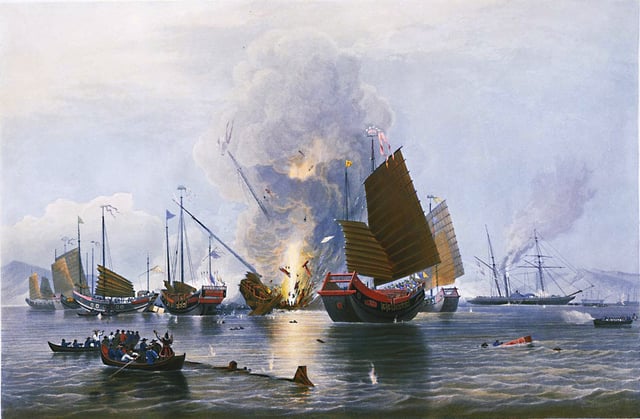
British Steamship destroying Chinese war junks (E. Duncan) (1843)

View of the Canton River, showing the Thirteen Factories in the background, 1850–1855
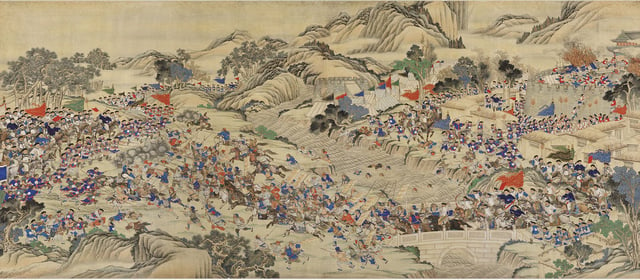
A scene of the Taiping Rebellion, 1850–1864
At the start of the dynasty, the Chinese empire continued to be the hegemonic power in East Asia. Although there was no formal ministry of foreign relations, the Lifan Yuan was responsible for relations with the Mongol and Tibetans in Central Asia, while the tributary system, a loose set of institutions and customs taken over from the Ming, in theory governed relations with East and Southeast Asian countries. The Treaty of Nerchinsk (1689) stabilized relations with Czarist Russia.
In the Jahriyya revolt sectarian violence between two suborders of the Naqshbandi Sufis, the Jahriyya Sufi Muslims and their rivals, the Khafiyya Sufi Muslims, led to a Jahriyya Sufi Muslim rebellion which the Qing dynasty in China crushed with the help of the Khafiyya Sufi Muslims.[121] The Eight Trigrams uprising of 1813 broke out in 1813.
However, during the 18th century European empires gradually expanded across the world, as European states developed economies built on maritime trade. The dynasty was confronted with newly developing concepts of the international system and state to state relations. European trading posts expanded into territorial control in nearby India and on the islands that are now Indonesia. The Qing response, successful for a time, was to establish the Canton System in 1756, which restricted maritime trade to that city (modern-day Guangzhou) and gave monopoly trading rights to private Chinese merchants. The British East India Company and the Dutch East India Company had long before been granted similar monopoly rights by their governments.
In 1793, the British East India Company, with the support of the British government, sent a delegation to China under Lord George Macartney in order to open free trade and put relations on a basis of equality. The imperial court viewed trade as of secondary interest, whereas the British saw maritime trade as the key to their economy. The Qianlong Emperor told Macartney "the kings of the myriad nations come by land and sea with all sorts of precious things", and "consequently there is nothing we lack ..."[122]
Demand in Europe for Chinese goods such as silk, tea, and ceramics could only be met if European companies funneled their limited supplies of silver into China. In the late 1700s, the governments of Britain and France were deeply concerned about the imbalance of trade and the drain of silver. To meet the growing Chinese demand for opium, the British East India Company greatly expanded its production in Bengal. Since China's economy was essentially self-sufficient, the country had little need to import goods or raw materials from the Europeans, so the usual way of payment was through silver. The Daoguang Emperor, concerned both over the outflow of silver and the damage that opium smoking was causing to his subjects, ordered Lin Zexu to end the opium trade. Lin confiscated the stocks of opium without compensation in 1839, leading Britain to send a military expedition the following year.
The First Opium War revealed the outdated state of the Chinese military. The Qing navy, composed entirely of wooden sailing junks, was severely outclassed by the modern tactics and firepower of the British Royal Navy. British soldiers, using advanced muskets and artillery, easily outmanoeuvred and outgunned Qing forces in ground battles. The Qing surrender in 1842 marked a decisive, humiliating blow to China. The Treaty of Nanjing, the first of the "unequal treaties", demanded war reparations, forced China to open up the Treaty Ports of Canton, Amoy, Fuchow, Ningpo and Shanghai to Western trade and missionaries, and to cede Hong Kong Island to Britain. It revealed weaknesses in the Qing government and provoked rebellions against the regime. In 1842, the Qing dynasty fought a war with the Sikh Empire (the last independent kingdom of India), resulting in a negotiated peace and a return to the status quo ante bellum.
The Taiping Rebellion in the mid-19th century was the first major instance of anti-Manchu sentiment. Amid widespread social unrest and worsening famine, the rebellion not only posed the most serious threat towards Qing rulers, it has also been called the "bloodiest civil war of all time"; during its fourteen-year course from 1850 to 1864 between 20 and 30 million people died.[123] Hong Xiuquan, a failed civil service candidate, in 1851 launched an uprising in Guizhou province, and established the Taiping Heavenly Kingdom with Hong himself as king. Hong announced that he had visions of God and that he was the brother of Jesus Christ. Slavery, concubinage, arranged marriage, opium smoking, footbinding, judicial torture, and the worship of idols were all banned. However, success led to internal feuds, defections and corruption. In addition, British and French troops, equipped with modern weapons, had come to the assistance of the Qing imperial army. It was not until 1864 that Qing armies under Zeng Guofan succeeded in crushing the revolt. After the outbreak of this rebellion, there were also revolts by the Muslims and Miao people of China against the Qing dynasty, most notably in the Miao Rebellion (1854–73) in Guizhou, the Panthay Rebellion (1856–1873) in Yunnan and the Dungan Revolt (1862–77) in the northwest.
The Western powers, largely unsatisfied with the Treaty of Nanjing, gave grudging support to the Qing government during the Taiping and Nian Rebellions. China's income fell sharply during the wars as vast areas of farmland were destroyed, millions of lives were lost, and countless armies were raised and equipped to fight the rebels. In 1854, Britain tried to re-negotiate the Treaty of Nanjing, inserting clauses allowing British commercial access to Chinese rivers and the creation of a permanent British embassy at Beijing.
In 1856, Qing authorities, in searching for a pirate, boarded a ship, the Arrow, which the British claimed had been flying the British flag, an incident which led to the Second Opium War. In 1858, facing no other options, the Xianfeng Emperor agreed to the Treaty of Tientsin, which contained clauses deeply insulting to the Chinese, such as a demand that all official Chinese documents be written in English and a proviso granting British warships unlimited access to all navigable Chinese rivers.
Ratification of the treaty in the following year led to a resumption of hostilities. In 1860, with Anglo-French forces marching on Beijing, the emperor and his court fled the capital for the imperial hunting lodge at Rehe. Once in Beijing, the Anglo-French forces looted the Old Summer Palace and, in an act of revenge for the arrest of several Englishmen, burnt it to the ground. Prince Gong, a younger half-brother of the emperor, who had been left as his brother's proxy in the capital, was forced to sign the Convention of Beijing. The humiliated emperor died the following year at Rehe.
Self-strengthening and the frustration of reforms
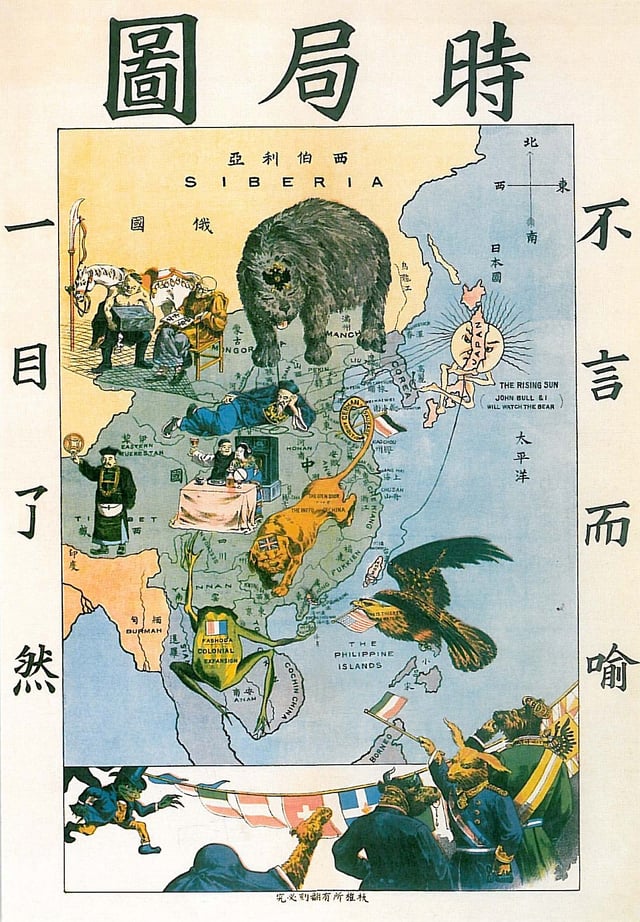
Imperialism 1900: The bear represents Russia, the lion Britain, the frog France, the sun Japan, and the eagle the United States.
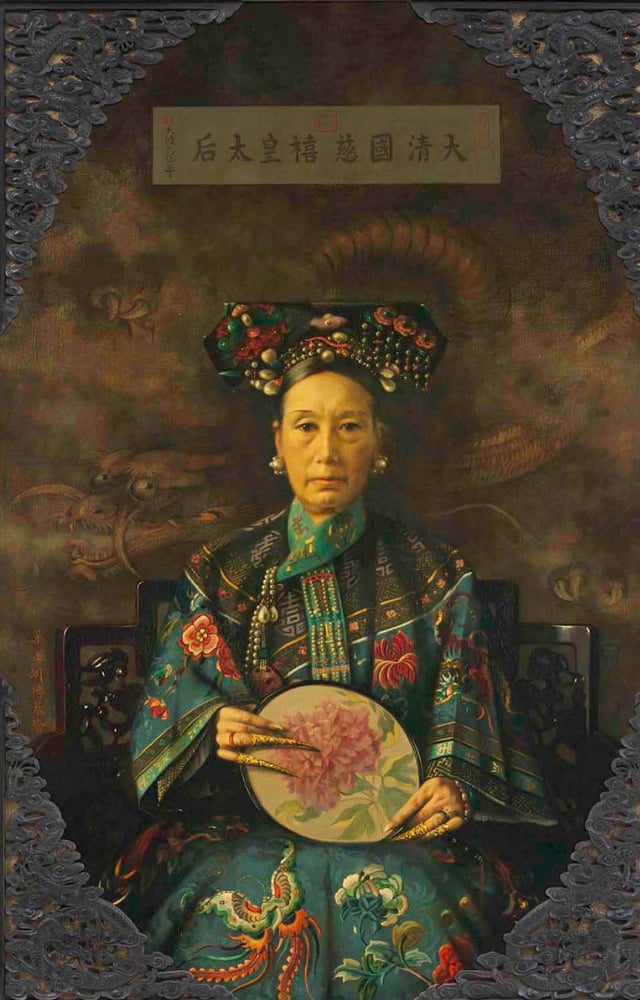
Painting of Empress Dowager Cixi by Dutch American artist Hubert Vos circa 1905

Foreign armies assemble inside the Forbidden City after capturing Beijing, 28 November 1900
Yet the dynasty rallied. Chinese generals and officials such as Zuo Zongtang led the suppression of rebellions and stood behind the Manchus. When the Tongzhi Emperor came to the throne at the age of five in 1861, these officials rallied around him in what was called the Tongzhi Restoration. Their aim was to adopt Western military technology in order to preserve Confucian values. Zeng Guofan, in alliance with Prince Gong, sponsored the rise of younger officials such as Li Hongzhang, who put the dynasty back on its feet financially and instituted the Self-Strengthening Movement. The reformers then proceeded with institutional reforms, including China's first unified ministry of foreign affairs, the Zongli Yamen; allowing foreign diplomats to reside in the capital; establishment of the Imperial Maritime Customs Service; the formation of modernized armies, such as the Beiyang Army, as well as a navy; and the purchase from Europeans of armament factories.[124][125]
The dynasty lost control of peripheral territories bit by bit. In return for promises of support against the British and the French, the Russian Empire took large chunks of territory in the Northeast in 1860. The period of cooperation between the reformers and the European powers ended with the Tientsin Massacre of 1870, which was incited by the murder of French nuns set off by the belligerence of local French diplomats. Starting with the Cochinchina Campaign in 1858, France expanded control of Indochina. By 1883, France was in full control of the region and had reached the Chinese border. The Sino-French War began with a surprise attack by the French on the Chinese southern fleet at Fuzhou. After that the Chinese declared war on the French. A French invasion of Taiwan was halted and the French were defeated on land in Tonkin at the Battle of Bang Bo. However Japan threatened to enter the war against China due to the Gapsin Coup and China chose to end the war with negotiations. The war ended in 1885 with the Treaty of Tientsin (1885) and the Chinese recognition of the French protectorate in Vietnam.[126]
In 1884, pro-Japanese Koreans in Seoul led the Gapsin Coup. Tensions between China and Japan rose after China intervened to suppress the uprising. Japanese Prime Minister Itō Hirobumi and Li Hongzhang signed the Convention of Tientsin, an agreement to withdraw troops simultaneously, but the First Sino-Japanese War of 1895 was a military humiliation. The Treaty of Shimonoseki recognized Korean independence and ceded Taiwan and the Pescadores to Japan. The terms might have been harsher, but when a Japanese citizen attacked and wounded Li Hongzhang, an international outcry shamed the Japanese into revising them. The original agreement stipulated the cession of Liaodong Peninsula to Japan, but Russia, with its own designs on the territory, along with Germany and France, in what was known as the Triple Intervention, successfully put pressure on the Japanese to abandon the peninsula.
These years saw an evolution in the participation of Empress Dowager Cixi (Wade–Giles: Tz'u-Hsi) in state affairs. She entered the imperial palace in the 1850s as a concubine to the Xianfeng Emperor (r. 1850–1861) and came to power in 1861 after her five-year-old son, the Tongzhi Emperor ascended the throne. She, the Empress Dowager Ci'an (who had been Xianfeng's empress), and Prince Gong (a son of the Daoguang Emperor), staged a coup that ousted several regents for the boy emperor. Between 1861 and 1873, she and Ci'an served as regents, choosing the reign title "Tongzhi" (ruling together). Following the emperor's death in 1875, Cixi's nephew, the Guangxu Emperor, took the throne, in violation of the dynastic custom that the new emperor be of the next generation, and another regency began. In the spring of 1881, Ci'an suddenly died, aged only forty-three, leaving Cixi as sole regent.[127]
From 1889, when Guangxu began to rule in his own right, to 1898, the Empress Dowager lived in semi-retirement, spending the majority of the year at the Summer Palace. On 1 November 1897, two German Roman Catholic missionaries were murdered in the southern part of Shandong province (the Juye Incident). Germany used the murders as a pretext for a naval occupation of Jiaozhou Bay. The occupation prompted a "scramble for concessions" in 1898, which included the German lease of Jiazhou Bay, the Russian acquisition of Liaodong, and the British lease of the New Territories of Hong Kong.
In the wake of these external defeats, the Guangxu Emperor initiated the Hundred Days' Reform of 1898. Newer, more radical advisers such as Kang Youwei were given positions of influence. The emperor issued a series of edicts and plans were made to reorganize the bureaucracy, restructure the school system, and appoint new officials. Opposition from the bureaucracy was immediate and intense. Although she had been involved in the initial reforms, the Empress Dowager stepped in to call them off, arrested and executed several reformers, and took over day-to-day control of policy. Yet many of the plans stayed in place, and the goals of reform were implanted.[128]
Widespread drought in North China, combined with the imperialist designs of European powers and the instability of the Qing government, created conditions that led to the emergence of the Righteous and Harmonious Fists, or "Boxers." In 1900, local groups of Boxers proclaiming support for the Qing dynasty murdered foreign missionaries and large numbers of Chinese Christians, then converged on Beijing to besiege the Foreign Legation Quarter. A coalition of European, Japanese, and Russian armies (the Eight-Nation Alliance) then entered China without diplomatic notice, much less permission. Cixi declared war on all of these nations, only to lose control of Beijing after a short, but hard-fought campaign. She fled to Xi'an. The victorious allies drew up scores of demands on the Qing government, including compensation for their expenses in invading China and execution of complicit officials.[129]
Reform, revolution, collapse
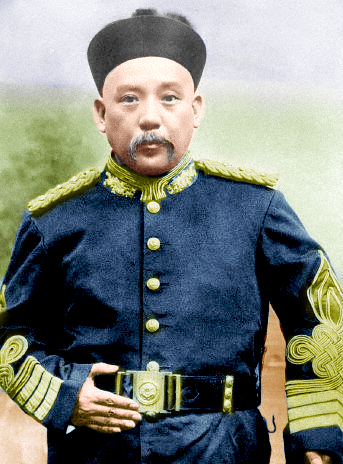
Yuan Shikai
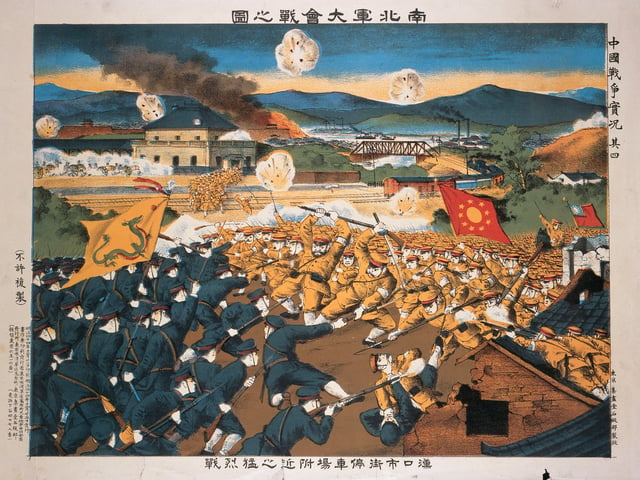
Pitched battle between the imperial and revolutionary army in 1911
By the early 20th century, mass civil disorder had begun in China, and it was growing continuously. To overcome such problems, Empress Dowager Cixi issued an imperial edict in 1901 calling for reform proposals from the governors-general and governors and initiated the era of the dynasty's "New Policies", also known as the "Late Qing Reform". The edict paved the way for the most far-reaching reforms in terms of their social consequences, including the creation of a national education system and the abolition of the imperial examinations in 1905.[130]
The Guangxu Emperor died on 14 November 1908, and on 15 November 1908, Cixi also died. Rumors held that she or Yuan Shikai ordered trusted eunuchs to poison the Guangxu Emperor, and an autopsy conducted nearly a century later confirmed lethal levels of arsenic in his corpse.[131] Puyi, the oldest son of Zaifeng, Prince Chun, and nephew to the childless Guangxu Emperor, was appointed successor at the age of two, leaving Zaifeng with the regency. This was followed by the dismissal of General Yuan Shikai from his former positions of power. In April 1911 Zaifeng created a cabinet in which there were two vice-premiers. Nonetheless, this cabinet was also known by contemporaries as "The Royal Cabinet" because among the thirteen cabinet members, five were members of the imperial family or Aisin Gioro relatives.[132] This brought a wide range of negative opinions from senior officials like Zhang Zhidong. The Wuchang Uprising of 10 October 1911 was a success; by November 14 of the 15 provinces had rejected Qing rule. This led to the creation of a new central government, the Republic of China, in Nanjing with Sun Yat-sen as its provisional head. Many provinces soon began "separating" from Qing control. Seeing a desperate situation unfold, the Qing government brought Yuan Shikai back to military power. He took control of his Beiyang Army to crush the revolution in Wuhan at the Battle of Yangxia. After taking the position of Prime Minister and creating his own cabinet, Yuan Shikai went as far as to ask for the removal of Zaifeng from the regency. This removal later proceeded with directions from Empress Dowager Longyu. Yuan Shikai was now a dictator--the ruler of China and the Manchu dynasty had lost all power; it formally abdicated in early 1912.
Premier Yuan Shikai and his Beiyang commanders decided that going to war would be unreasonable and costly. Similarly, Sun Yat-sen wanted a republican constitutional reform, for the benefit of China's economy and populace. With permission from Empress Dowager Longyu, Yuan Shikai began negotiating with Sun Yat-sen, who decided that his goal had been achieved in forming a republic, and that therefore he could allow Yuan to step into the position of President of the Republic of China.
On 12 February 1912, after rounds of negotiations, Longyu issued an imperial edict bringing about the abdication of the child emperor Puyi. This brought an end to over 2,000 years of Imperial China and began an extended period of instability of warlord factionalism. The unorganized political and economic systems combined with a widespread criticism of Chinese culture led to questioning and doubt about the future. Some Qing loyalists organized themselves as "Royalist Party", and tried to use militant activism and open rebellions to restore the monarchy, but to no avail.[133] In July 1917, there was an abortive attempt to restore the Qing dynasty led by Zhang Xun, which was quickly reversed by republican troops. In the 1930s, the Empire of Japan invaded Northeast China and founded Manchukuo in 1932, with Puyi as its emperor. After the invasion by the Soviet Union, Manchukuo fell in 1945.
Government
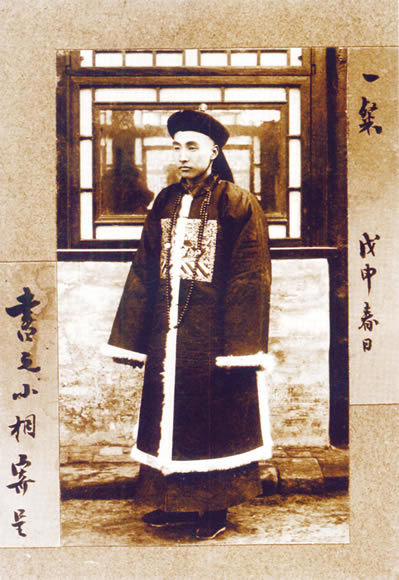
A Qing dynasty mandarin
The early Qing emperors adopted the bureaucratic structures and institutions from the preceding Ming dynasty but split rule between Han Chinese and Manchus, with some positions also given to Mongols.[134] Like previous dynasties, the Qing recruited officials via the imperial examination system, until the system was abolished in 1905. The Qing divided the positions into civil and military positions, each having nine grades or ranks, each subdivided into a and b categories. Civil appointments ranged from an attendant to the emperor or a Grand Secretary in the Forbidden City (highest) to being a prefectural tax collector, deputy jail warden, deputy police commissioner, or tax examiner. Military appointments ranged from being a field marshal or chamberlain of the imperial bodyguard to a third class sergeant, corporal or a first or second class private.[135]
Central government agencies
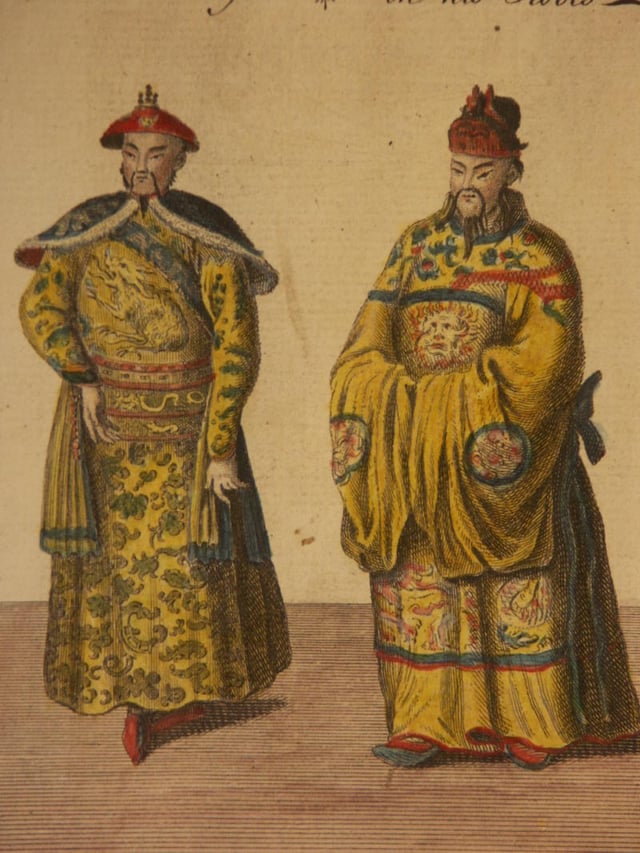
The emperor of China from The Universal Traveller

2000–cash Da-Qing Baochao banknote from 1859
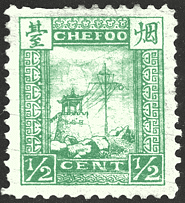
A postage stamp from Yantai (Chefoo) in the Qing dynasty
The formal structure of the Qing government centered on the Emperor as the absolute ruler, who presided over six Boards (Ministries[4]), each headed by two presidents[5] and assisted by four vice presidents.[6] In contrast to the Ming system, however, Qing ethnic policy dictated that appointments were split between Manchu noblemen and Han officials who had passed the highest levels of the state examinations. The Grand Secretariat,[7] which had been an important policy-making body under the Ming, lost its importance during the Qing and evolved into an imperial chancery. The institutions which had been inherited from the Ming formed the core of the Qing "Outer Court," which handled routine matters and was located in the southern part of the Forbidden City.
In order not to let the routine administration take over the running of the empire, the Qing emperors made sure that all important matters were decided in the "Inner Court," which was dominated by the imperial family and Manchu nobility and which was located in the northern part of the Forbidden City. The core institution of the inner court was the Grand Council.[8] It emerged in the 1720s under the reign of the Yongzheng Emperor as a body charged with handling Qing military campaigns against the Mongols, but it soon took over other military and administrative duties and served to centralize authority under the crown.[136] The Grand Councillors[9] served as a sort of privy council to the emperor.
The Six Ministries and their respective areas of responsibilities were as follows:
Board of Civil Appointments[10]
- The personnel administration of all civil officials – including evaluation, promotion, and dismissal. It was also in charge of the "honours list".
Board of Revenue[11]
- The literal translation of the Chinese word hu (户) is "household". For much of Qing history, the government's main source of revenue came from taxation on landownership supplemented byofficial monopolies on salt, which was an essential household item, and tea. Thus, in the predominantly agrarian Qing dynasty, the "household" was the basis of imperial finance. The department was charged with revenue collection and the financial management of the government.
Board of Rites[12]
- This board was responsible for all matters concerning court protocol. It organized the periodic worship of ancestors and various gods by the emperor, managed relations withtributary nations, and oversaw the nationwidecivil examination system.
Board of War[13]
- Unlike its Ming predecessor, which had full control over all military matters, the Qing Board of War had very limited powers. First, theEight Bannerswere under the direct control of the emperor and hereditary Manchu and Mongol princes, leaving the ministry only with authority over theGreen Standard Army. Furthermore, the ministry's functions were purely administrative. Campaigns and troop movements were monitored and directed by the emperor, first through the Manchu ruling council, and later through the Grand Council.
Board of Punishments[14]
- The Board of Punishments handled all legal matters, including the supervision of various law courts and prisons. TheQing legal frameworkwas relatively weak compared to modern day legal systems, as there was no separation of executive and legislative branches of government. The legal system could be inconsistent, and, at times, arbitrary, because the emperor ruled by decree and had final say on all judicial outcomes. Emperors could (and did) overturn judgements of lower courts from time to time. Fairness of treatment was also an issue under the system of control practised by the Manchu government over the Han Chinese majority. To counter these inadequacies and keep the population in line, the Qing government maintained a very harsh penal code towards the Han populace, but it was no more severe than previous Chinese dynasties.
Board of Works[15]
- The Board of Works handled all governmental building projects, including palaces, temples and the repairs of waterways and flood canals. It was also in charge of minting coinage.
From the early Qing, the central government was characterized by a system of dual appointments by which each position in the central government had a Manchu and a Han Chinese assigned to it. The Han Chinese appointee was required to do the substantive work and the Manchu to ensure Han loyalty to Qing rule.[137] The distinction between Han Chinese and Manchus extended to their court costumes. During the Qianlong Emperor's reign, for example, members of his family were distinguished by garments with a small circular emblem on the back, whereas Han officials wore clothing with a square emblem.
In addition to the six boards, there was a Lifan Yuan[16] unique to the Qing government. This institution was established to supervise the administration of Tibet and the Mongol lands. As the empire expanded, it took over administrative responsibility of all minority ethnic groups living in and around the empire, including early contacts with Russia – then seen as a tribute nation. The office had the status of a full ministry and was headed by officials of equal rank. However, appointees were at first restricted only to candidates of Manchu and Mongol ethnicity, until later open to Han Chinese as well.
Even though the Board of Rites and Lifan Yuan performed some duties of a foreign office, they fell short of developing into a professional foreign service. It was not until 1861 – a year after losing the Second Opium War to the Anglo-French coalition – that the Qing government bowed to foreign pressure and created a proper foreign affairs office known as the Zongli Yamen. The office was originally intended to be temporary and was staffed by officials seconded from the Grand Council. However, as dealings with foreigners became increasingly complicated and frequent, the office grew in size and importance, aided by revenue from customs duties which came under its direct jurisdiction.
There was also another government institution called Imperial Household Department which was unique to the Qing dynasty. It was established before the fall of the Ming, but it became mature only after 1661, following the death of the Shunzhi Emperor and the accession of his son, the Kangxi Emperor.[138] The department's original purpose was to manage the internal affairs of the imperial family and the activities of the inner palace (in which tasks it largely replaced eunuchs), but it also played an important role in Qing relations with Tibet and Mongolia, engaged in trading activities (jade, ginseng, salt, furs, etc.), managed textile factories in the Jiangnan region, and even published books.[139] Relations with the Salt Superintendents and salt merchants, such as those at Yangzhou, were particularly lucrative, especially since they were direct, and did not go through absorptive layers of bureaucracy. The department was manned by booi,[17] or "bondservants," from the Upper Three Banners.[140] By the 19th century, it managed the activities of at least 56 subagencies.[138][141]
Administrative divisions

The Qing Empire ca. 1820

Qing dynasty in 1820, with provinces in yellow, military governorates and protectorates in light yellow, tributary states in orange.
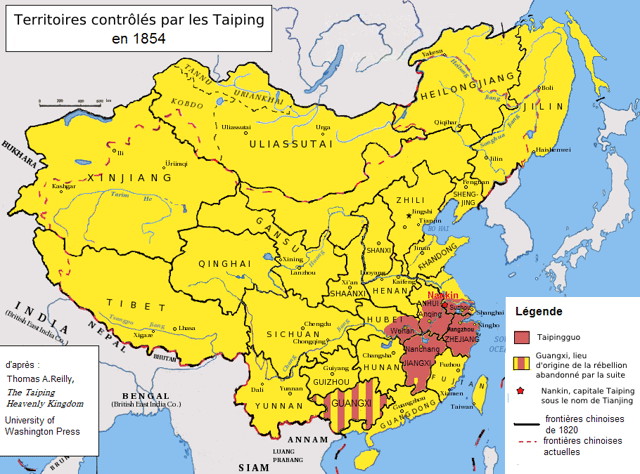
Qing dynasty in 1854
Qing China reached its largest extent during the 18th century, when it ruled China proper (eighteen provinces) as well as the areas of present-day Northeast China, Inner Mongolia, Outer Mongolia, Xinjiang and Tibet, at approximately 13 million km2 in size. There were originally 18 provinces, all of which in China proper, but later this number was increased to 22, with Manchuria and Xinjiang being divided or turned into provinces. Taiwan, originally part of Fujian province, became a province of its own in the 19th century, but was ceded to the Empire of Japan following the First Sino-Japanese War by the end of the century. In addition, many surrounding countries, such as Korea (Joseon dynasty), Vietnam frequently paid tribute to China during much of this period. The Katoor dynasty of Afghanistan also paid tribute to the Qing dynasty of China until the mid-19th century.[142] During the Qing dynasty the Chinese claimed suzerainty over the Taghdumbash Pamir in the south-west of Taxkorgan Tajik Autonomous County but permitted the Mir of Hunza to administer the region in return for a tribute. Until 1937 the inhabitants paid tribute to the Mir of Hunza, who exercised control over the pastures.[143] Khanate of Kokand were forced to submit as protectorate and pay tribute to the Qing dynasty in China between 1774 and 1798.
Northern and southern circuits of Tian Shan (later became Xinjiang province) – sometimes the small semi-autonomous Kumul Khanate and Turfan Khanate are placed into an "Eastern Circuit"
Outer Mongolia – Khalkha, Kobdo league, Köbsgöl, Tannu Urianha
Inner Mongolia – 6 leagues (Jirim, Josotu, Juu Uda, Shilingol, Ulaan Chab, Ihe Juu)
Other Mongolian leagues – Alshaa khoshuu (League-level khoshuu), Ejine khoshuu, Ili khoshuu (in Xinjiang), Köke Nuur league; directly ruled areas: Dariganga (Special region designated as Emperor's pasture), Guihua Tümed, Chakhar, Hulunbuir
Tibet (Ü-Tsang and western Kham, approximately the area of present-day Tibet Autonomous Region)
Manchuria (Northeast China, later became provinces)
Eighteen provinces (China proper provinces)
Additional provinces in the late Qing dynasty
Gansu-Xinjiang
Fujian-Taiwan (until 1895)
Fengtian
Jilin
Heilongjiang
Territorial administration
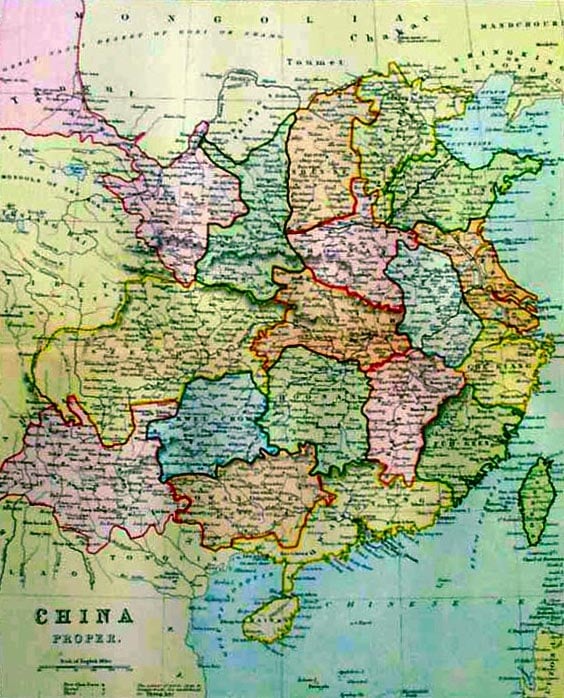
The Eighteen Provinces of China proper in 1875 – the core territories of China, inside the Great Wall of China, controlled by the majority of China's historical dynasties.
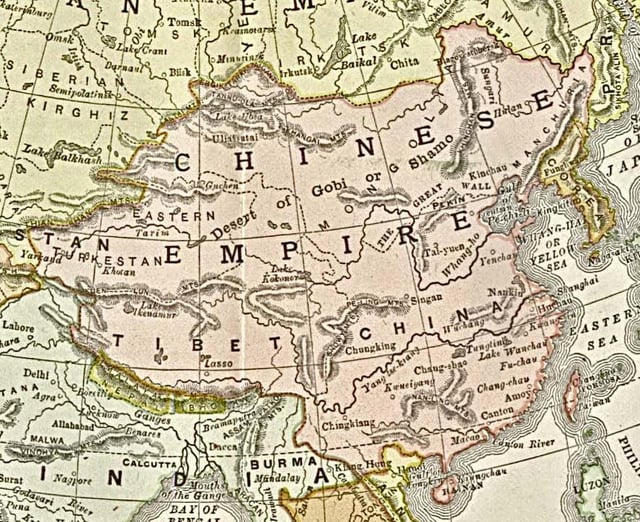
Qing China in 1892
The Qing organization of provinces was based on the fifteen administrative units set up by the Ming dynasty, later made into eighteen provinces by splitting for example, Huguang into Hubei and Hunan provinces. The provincial bureaucracy continued the Yuan and Ming practice of three parallel lines, civil, military, and censorate, or surveillance. Each province was administered by a governor (巡撫, xunfu) and a provincial military commander (提督, tidu). Below the province were prefectures (府, fu) operating under a prefect (知府, zhīfǔ), followed by subprefectures under a subprefect. The lowest unit was the county, overseen by a county magistrate. The eighteen provinces are also known as "China proper". The position of viceroy or governor-general (總督, zongdu) was the highest rank in the provincial administration. There were eight regional viceroys in China proper, each usually took charge of two or three provinces. The Viceroy of Zhili, who was responsible for the area surrounding the capital Beijing, is usually considered as the most honorable and powerful viceroy among the eight.
Viceroy of Zhili – in charge of Zhili
Viceroy of Shaan-Gan – in charge of Shaanxi and Gansu
Viceroy of Liangjiang – in charge of Jiangsu, Jiangxi, and Anhui
Viceroy of Huguang – in charge of Hubei and Hunan
Viceroy of Sichuan – in charge of Sichuan
Viceroy of Min-Zhe – in charge of Fujian, Taiwan, and Zhejiang
Viceroy of Liangguang – in charge of Guangdong and Guangxi
Viceroy of Yun-Gui – in charge of Yunnan and Guizhou
By the mid-18th century, the Qing had successfully put outer regions such as Inner and Outer Mongolia, Tibet and Xinjiang under its control. Imperial commissioners and garrisons were sent to Mongolia and Tibet to oversee their affairs. These territories were also under supervision of a central government institution called Lifan Yuan. Qinghai was also put under direct control of the Qing court. Xinjiang, also known as Chinese Turkestan, was subdivided into the regions north and south of the Tian Shan mountains, also known today as Dzungaria and Tarim Basin respectively, but the post of Ili General was established in 1762 to exercise unified military and administrative jurisdiction over both regions. Dzungaria was fully opened to Han migration by the Qianlong Emperor from the beginning. Han migrants were at first forbidden from permanently settling in the Tarim Basin but were the ban was lifted after the invasion by Jahangir Khoja in the 1820s. Likewise, Manchuria was also governed by military generals until its division into provinces, though some areas of Xinjiang and Northeast China were lost to the Russian Empire in the mid-19th century. Manchuria was originally separated from China proper by the Inner Willow Palisade, a ditch and embankment planted with willows intended to restrict the movement of the Han Chinese, as the area was off-limits to civilian Han Chinese until the government started colonizing the area, especially since the 1860s.[144]
With respect to these outer regions, the Qing maintained imperial control, with the emperor acting as Mongol khan, patron of Tibetan Buddhism and protector of Muslims. However, Qing policy changed with the establishment of Xinjiang province in 1884. During The Great Game era, taking advantage of the Dungan revolt in northwest China, Yaqub Beg invaded Xinjiang from Central Asia with support from the British Empire, and made himself the ruler of the kingdom of Kashgaria. The Qing court sent forces to defeat Yaqub Beg and Xinjiang was reconquered, and then the political system of China proper was formally applied onto Xinjiang. The Kumul Khanate, which was incorporated into the Qing empire as a vassal after helping Qing defeat the Zunghars in 1757, maintained its status after Xinjiang turned into a province through the end of the dynasty in the Xinhai Revolution up until 1930.[145] In the early 20th century, Britain sent an expedition force to Tibet and forced Tibetans to sign a treaty. The Qing court responded by asserting Chinese sovereignty over Tibet,[146] resulting in the 1906 Anglo-Chinese Convention signed between Britain and China. The British agreed not to annex Tibetan territory or to interfere in the administration of Tibet, while China engaged not to permit any other foreign state to interfere with the territory or internal administration of Tibet.[147] Furthermore, similar to Xinjiang which was converted into a province earlier, the Qing government also turned Manchuria into three provinces in the early 20th century, officially known as the "Three Northeast Provinces", and established the post of Viceroy of the Three Northeast Provinces to oversee these provinces, making the total number of regional viceroys to nine.
Military
Beginnings and early development
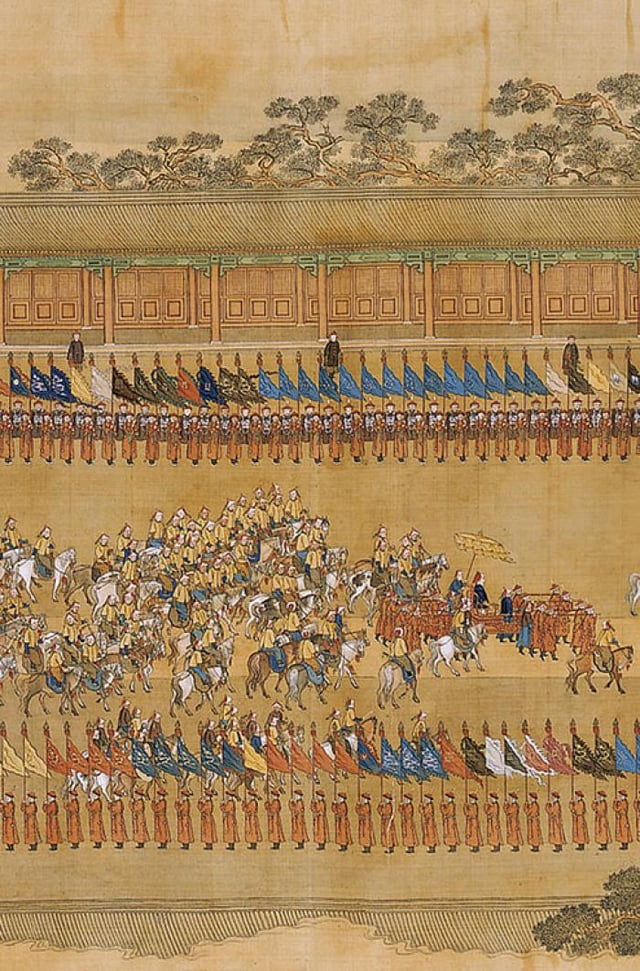
The Qianlong Emperor's Southern Inspection Tour, Scroll Twelve: Return to the Palace (detail), 1764 – 1770, by Xu Yang
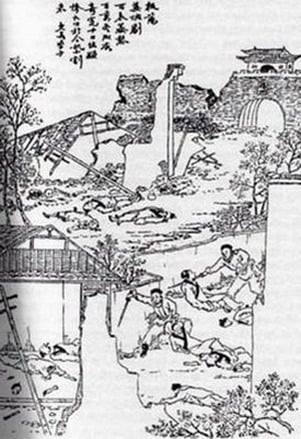
A late-Qing woodblock print representing the Yangzhou massacre of May 1645. By the late 19th century, the massacre was used by anti-Qing revolutionaries to arouse anti-Manchu sentiment among the population.
The early Qing military was rooted in the Eight Banners first developed by Nurhaci to organize Jurchen society beyond petty clan affiliations. There were eight banners in all, differentiated by color. The yellow, bordered yellow, and white banners were known as the "Upper Three Banners" and were under the direct command of the emperor. Only Manchus belonging to the Upper Three Banners, and selected Han Chinese who had passed the highest level of martial exams could serve as the emperor's personal bodyguards. The remaining Banners were known as the "Lower Five Banners". They were commanded by hereditary Manchu princes descended from Nurhachi's immediate family, known informally as the "Iron cap princes". Together they formed the ruling council of the Manchu nation as well as high command of the army. Nurhachi's son Hong Taiji expanded the system to include mirrored Mongol and Han Banners. After capturing Beijing in 1644, the relatively small Banner armies were further augmented by the Green Standard Army, made up of those Ming troops who had surrendered to the Qing, which eventually outnumbered Banner troops three to one. They maintained their Ming era organization and were led by a mix of Banner and Green Standard officers.
Banner Armies were organized along ethnic lines, namely Manchu and Mongol, but included non-Manchu bondservants registered under the household of their Manchu masters. The years leading up to the conquest increased the number of Han Chinese under Manchu rule, leading Hong Taiji to create the Eight Han Banners, and around the time of the Qing takeover of Beijing, their numbers rapidly swelled.[148] Han Bannermen held high status and power in the early Qing period, especially immediately after the conquest during Shunzhi and Kangxi's reign where they dominated Governor-Generalships and Governorships across China at the expense of both Manchu Bannermen and Han civilians. Han also numerically dominated the Banners up until the mid 18th century. European visitors in Beijing called them "Tartarized Chinese" or "Tartarified Chinese".
The Qianlong Emperor, concerned about maintaining Manchu identity, re-emphasized Manchu ethnicity, ancestry, language, and culture in the Eight Banners and started a mass discharge of Han Bannermen from the Eight Banners, either asking them to voluntarily resign from the Banner rolls or striking their names off. This led to a change from Han majority to a Manchu majority within the Banner system,[149] and previous Han Bannermen garrisons in southern China such as at Fuzhou, Zhenjiang, Guangzhou, were replaced by Manchu Bannermen in the purge, which started in 1754. The turnover by Qianlong most heavily impacted Han banner garrisons stationed in the provinces while it less impacted Han Bannermen in Beijing, leaving a larger proportion of remaining Han Bannermen in Beijing than the provinces.[150] Han Bannermen's status was decreased from that point on with Manchu Banners gaining higher status. Han Bannermen numbered 75% in 1648 Shunzhi's reign, 72% in 1723 Yongzheng's reign, but decreased to 43% in 1796 during the first year of Jiaqing's reign, which was after Qianlong's purge. The mass discharge was known as the Disbandment of the Han Banners. Qianlong directed most of his ire at those Han Bannermen descended from defectors who joined the Qing after the Qing passed through the Great Wall at Shanhai Pass in 1644, deeming their ancestors as traitors to the Ming and therefore untrustworthy, while retaining Han Bannermen who were descended from defectors who joined the Qing before 1644 in Liaodong and marched through Shanhai pass, also known as those who "followed the Dragon through the pass" (從龍入關; cong long ru guan).
After a century of peace the Manchu Banner troops lost their fighting edge. Before the conquest, the Manchu banner had been a "citizen" army whose members were farmers and herders obligated to provide military service in times of war. The decision to turn the banner troops into a professional force whose every need was met by the state brought wealth, corruption, and decline as a fighting force. The Green Standard Army declined in a similar way.
Rebellion and modernization
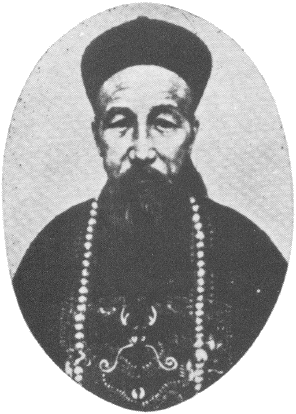
General Zeng Guofan

In 1894–1895, fighting over influence in Korea, Japanese troops defeated Qing forces.
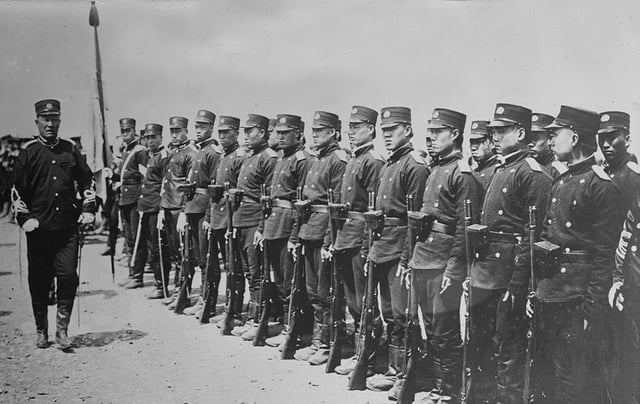
The New Army in training
Early during the Taiping Rebellion, Qing forces suffered a series of disastrous defeats culminating in the loss of the regional capital city of Nanjing in 1853. Shortly thereafter, a Taiping expeditionary force penetrated as far north as the suburbs of Tianjin, the imperial heartlands. In desperation the Qing court ordered a Chinese official, Zeng Guofan, to organize regional and village militias into an emergency army called tuanlian. Zeng Guofan's strategy was to rely on local gentry to raise a new type of military organization from those provinces that the Taiping rebels directly threatened. This new force became known as the Xiang Army, named after the Hunan region where it was raised. The Xiang Army was a hybrid of local militia and a standing army. It was given professional training, but was paid for out of regional coffers and funds its commanders – mostly members of the Chinese gentry – could muster. The Xiang Army and its successor, the Huai Army, created by Zeng Guofan's colleague and protégée Li Hongzhang, were collectively called the "Yong Ying" (Brave Camp).[151]
Zeng Guofan had no prior military experience. Being a classically educated official, he took his blueprint for the Xiang Army from the Ming general Qi Jiguang, who, because of the weakness of regular Ming troops, had decided to form his own "private" army to repel raiding Japanese pirates in the mid-16th century. Qi Jiguang's doctrine was based on Neo-Confucian ideas of binding troops' loyalty to their immediate superiors and also to the regions in which they were raised. Zeng Guofan's original intention for the Xiang Army was simply to eradicate the Taiping rebels. However, the success of the Yongying system led to its becoming a permanent regional force within the Qing military, which in the long run created problems for the beleaguered central government.
First, the Yongying system signaled the end of Manchu dominance in Qing military establishment. Although the Banners and Green Standard armies lingered on as a drain on resources, henceforth the Yongying corps became the Qing government's de facto first-line troops. Second, the Yongying corps were financed through provincial coffers and were led by regional commanders, weakening central government's grip on the whole country. Finally, the nature of Yongying command structure fostered nepotism and cronyism amongst its commanders, who laid the seeds of regional warlordism in the first half of the 20th century.[152]
By the late 19th century, the most conservative elements within the Qing court could no longer ignore China's military weakness. In 1860, during the Second Opium War, the capital Beijing was captured and the Summer Palace sacked by a relatively small Anglo-French coalition force numbering 25,000. The advent of modern weaponry resulting from the European Industrial Revolution had rendered China's traditionally trained and equipped army and navy obsolete. The government attempts to modernize during the Self-Strengthening Movement were initially successful, but yielded few lasting results because of the central government's lack of funds, lack of political will, and unwillingness to depart from tradition.[153]
Losing the First Sino-Japanese War of 1894–1895 was a watershed. Japan, a country long regarded by the Chinese as little more than an upstart nation of pirates, annihilated the Qing government's modernized Beiyang Fleet, then deemed to be the strongest naval force in Asia. The Japanese victory occurred a mere three decades after the Meiji Restoration set a feudal Japan on course to emulate the Western nations in their economic and technological achievements. Finally, in December 1894, the Qing government took concrete steps to reform military institutions and to re-train selected units in Westernized drills, tactics and weaponry. These units were collectively called the New Army. The most successful of these was the Beiyang Army under the overall supervision and control of a former Huai Army commander, General Yuan Shikai, who used his position to build networks of loyal officers and eventually become President of the Republic of China.[154]
Society
Population growth
The most significant fact of early and mid-Qing social history was population growth. The population doubled during the 18th century. One of the main reasons for this growth was the increase in New World crops like peanuts, sweet potatoes, and potatoes, which helped to sustain the people during shortages of harvest for crops such as rice or wheat. This was because these crops were often easier to grow and thus cheaper as well, which led to them becoming staples for poorer farmers.[155] Another reason, aided by the farming of the new crops, was the decrease in the number of deaths previously caused from the dangers of malnutrition. Diseases such as smallpox, which had been quite widespread in the seventeenth century, that had formerly terrorized the population were brought under control due to a new increase in vaccines. In addition, infant deaths were also greatly decreased due to improvements in birthing techniques and childcare performed by doctors and midwives and through an increase in medical books available to the public. There was also a great decrease in the practice of infanticide, which had previously been more prevalent towards but not limited to girls. Such a harsh process had previously been the result of fights for opportunities and livelihood and its drop was likely the most significant reason for China's rapid growth in population.[156]
Also, according to one study, the homicide rate in Qing China "ranged between 0.35 and 1.47 per 100,000 inhabitants during the 1661–1898 period, a low level unmatched by Western Europe until the late 19th century. China's homicide rate rose steadily from 1661 to 1821 but declined gradually thereafter until the turn of the century."[157]
Movement
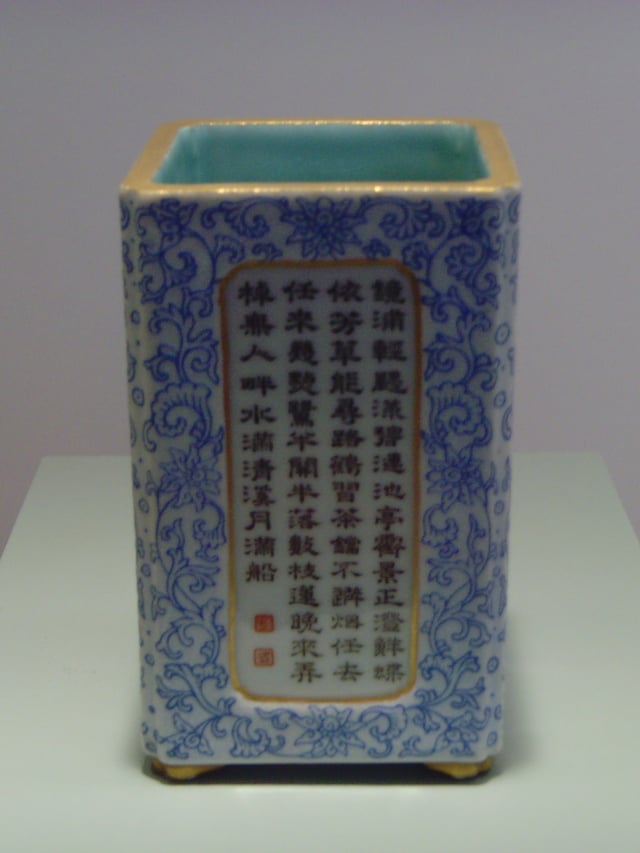
Qing era brush container
People in this period were also remarkably on the move. There is evidence suggesting that the empire's rapidly expanding population was geographically mobile on a scale, which, in term of its volume and its protracted and routinized nature, was unprecedented in Chinese history. Indeed, the Qing government did far more to encourage mobility than to discourage it. Migration took several different forms, though might be divided in two varieties: permanent migration for resettlement, and relocation conceived by the party (in theory at least) as a temporary sojourn. Parties to the latter would include the empire's increasingly large and mobile manual workforce, as well as its densely overlapping internal diaspora of local-origin-based merchant groups. It would also included the patterned movement of Qing subjects overseas, largely to Southeastern Asia, in search of trade and other economic opportunities.[158]
Statuses in society
According to statute, Qing society was divided into relatively closed estates, of which in most general terms there were five. Apart from the estates of the officials, the comparatively minuscule aristocracy, and the degree-holding literati, there also existed a major division among ordinary Chinese between commoners and people with inferior status.[159] They were divided into two categories: one of them, the good "commoner" people, the other "mean" people who were seen as debased and servile. The majority of the population belonged to the first category and were described as liangmin, a legal term meaning good people, as opposed to jianmin meaning the mean (or ignoble) people. Qing law explicitly stated that the traditional four occupational groups of scholars, farmers, artisans and merchants were "good", or having a status of commoners. On the other hand, slaves or bondservants, entertainers (including prostitutes and actors), tattooed criminals, and those low-level employees of government officials were the "mean people". Mean people were considered legally inferior to commoners and suffered unequal treatments, forbidden to take the imperial examination.[160] Furthermore, such people were usually not allowed to marry with free commoners and were even often required to acknowledge their abasement in society through actions such as bowing. However, throughout the Qing dynasty, the emperor and his court, as well as the bureaucracy, worked towards reducing the distinctions between the debased and free but did not completely succeed even at the end of its era in merging the two classifications together.[156]
Qing gentry
Although the Qing gentry did not hold hereditary noble rank, they, like their British counterparts, were a group of elites who held imperial privileges and managed local affairs. Their public role was that of an imperially acknowledged male scholar and civil servant who had succeeded in passing in at least the first level of civil service examinations, held a degree, could legally wear gentry robes, was qualified for official service and could talk to other officials as equals even though the gentry may not be an official himself. It was not uncommon in the Qing that some of the gentry were officials who had served for one or two short terms in their youth and then "retired" to enjoy the glory of their status during their mid to later years. In terms of a more private role, the gentry included not only the males holding degrees but also their wives, descendants, some of their relatives, as well as some patrilineages who had once or perhaps never had someone who had held a degree.[156]
The Qing gentry were mostly prominently defined by their lifestyle. They lived more refined and comfortable lives than the commoners and were often known to use sedan-chairs as a mean to travel any significant distances. They were also usually quite literate and often tried to show off their intelligence, such as by wearing items like eyeglasses. Many were also known to have objects such as porcelain or pieces of art in their homes that served no purpose other than to be admired for their beauty. This was because not everyone could afford these luxuries and thus such unnecessary objects were seen as a form of class.[156]
Qing nobility
Gender roles
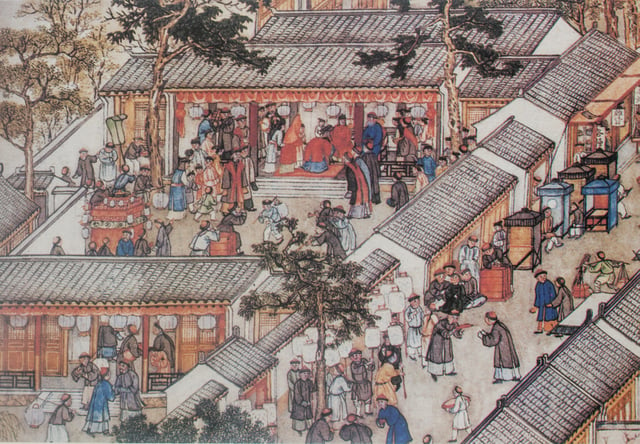
Marriage ceremony, Prosperous Suzhou by Xu Yang, 1759
In Qing society, women did not enjoy the same rights as men. The Confucian moral system, which was built by and thus favored men, restrained their rights, and they were often seen as a type of "merchandise" that could be traded away by their family. Once a woman married, she essentially became the property of her husband's family, and could not divorce her husband except under very specific circumstances, such as severe physical harm or an attempt to sell her into prostitution. Men, on the other hand, could divorce their wives for trivial matters such as excessive talkativeness. Furthermore, women were extremely restricted in owning property and inheritance and were essentially confined to their homes and stripped of social interaction and mobility. Mothers often bound their young daughters' feet, a practice that was seen as a standard of feminine beauty and a necessity to be marriageable, but was also a way to restrict a woman's physical movement in society.[156]
By early Qing, the romanticized courtesan culture, which had been much more popular in the late-Ming with men who had sought a model of a refinement and literacy that was missing from their marriage partners, had mostly disappeared. Such a decline was the result of the Qing's reinforced defense of fundamental Confucian family values as well as an attempt to put a stop to the cultural revolution that was happening at the time. The court thus began to rain down heavily on such practices as prostitution, pornography, rape, and homosexuality. However, by the time of the Qianlong emperor, red-light districts had once again become capitals of tasteful and trending courtesanship. In economically diverse port cities such as Tianjin, Chongqing, and Hankou, the sex trade became a large business, which helped supply a fine hierarchy of prostitutes to all classes of men. Shanghai, which had been rapidly growing in the late nineteenth century, became a city where prostitutes of different ranks whom male patrons fawned over and gossiped about, as some became recognized as national entities of femininity.[156]
Another rising phenomenon, especially during the eighteenth century, was the cult of widow chastity. The fact that many young women were betrothed during early adolescence coupled with the high rate of early mortality resulted in a significant number of young widows. This resulted in a problem, as most women had already moved into their husband's household and upon her husband's death essentially became a burden who could never fulfill her original duty of producing a male heir. Widow chastity began to be seen as a form of devout filiality for other relationships including loyalty to the emperor, which resulted in the Qing court's attempt to reward those families who resisted selling off their unneeded daughters-in-law in order to underline such women's virtue. However, this system began to decline when families who attempted to "abuse" the system appeared for social competition and authorities speculated that some families coerced their young widows to commit suicide at the time of their husband's death to obtain more honors. Such corruption showed a lack of respect for human life, and was thus greatly disapproved of by the officials who then chose to reward the families more sparingly.[156]
One of the main reasons for a shift in gender roles was the unprecedentedly high incidence of men leaving their homes to travel, which in turn gave women more freedom for action. Wives of such men often became the ones to run the household, especially in financial matters. Elite women also began to pursue different fashionable activities, such as writing poetry, and a new frenzy of female sociability appeared. Women started to leave their households to attend local opera performances and temple festivals and some even began to form little societies to visit famous sacred sites with other restless women, which helped to shape a new view of the conventional societal norms on how women should behave.[156]
Family and kinship
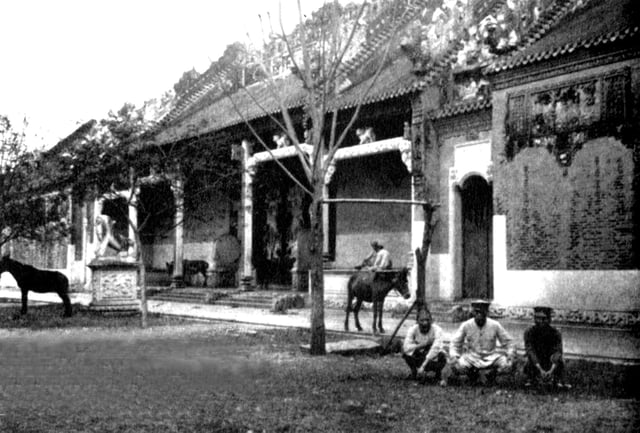
Chen Clan Ancestral Hall (陈家祠) built in 1894
Patrilineal kinship had compelling power socially and culturally and these local lineages became the building blocks of society. A person's success or failure depended, people believed, on guidance from a father, from which the family's success and prosperity also grew. The patrilineage kinship structure, that is, descent through the male line, was often translated as "clan" in earlier scholarship. By the Qing, the patrilineage had become the primary organizational device in society. This change began during the Song dynasty when the civil service examination became a means for gaining status versus nobility and inheritance of status. Elite families began to shift their marital practices, identity and loyalty. Instead of intermarrying within aristocratic elites of the same social status, they tended to form marital alliances with nearby families of the same or higher wealth, and established the local people's interests as first and foremost which helped to form intermarried townships. [161] The Neo-Confucian ideology particular Cheng-Zhu thinking adopted by the Qing placed emphasis on patrilineal families and genealogy in society.[162] Families in China were exhorted to compile genealogies by Qing Emperors.[163]
Inner Mongols and Khalkha Mongols in the Qing rarely knew their ancestors past 4 generations and Mongol tribal society was not organized among patrilineal clans contrary to what was commonly though, but included unrelated people at the base unit of organization.[164] The Qing tried but failed to promote the Chinese Neo-Confucian ideology of organizing society along patrimonial clans among the Mongols.[165]
Although Qing lineages claimed to be based on biological descent, they were often in fact purposefully crafted. When a member of a later generation gained office or became wealthy, he might look back to identify a "founding ancestor", sometimes using considerable creativity in selecting a prestigious local figure. Once such a person had been chosen, a character was assigned to be used in the given name of each male in succeeding generation. A written genealogy was compiled to record the lineage's history, biographies of respected ancestors, a chart of all the family members of each generation, rules for the members to abide, and often copies of title contracts for collective property as well. Lastly, an ancestral hall was built to serve as the lineage's headquarters and a place for annual ancestral sacrifice. [166] Such worship was intended to ensure that the ancestors remain content and benevolent spirits (shen) who would keep watch over and protect the family. The ancestral cult focuses on the family and lineage, rather than on more public matters such as community and nation.[155]
Economy
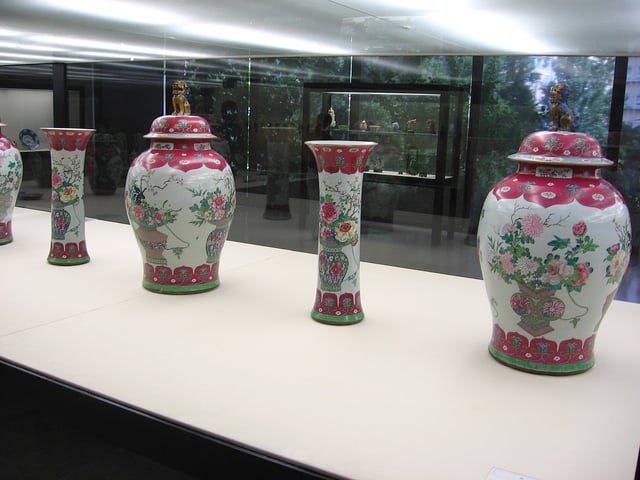
Qing vases, in the Calouste Gulbenkian Museum, Lisbon, Portugal
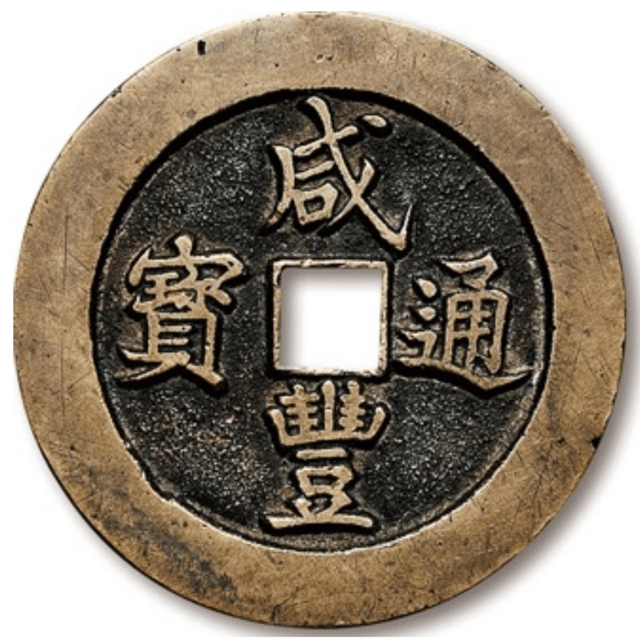
Xián Fēng Tōng Bǎo (咸豐通寶) 1850–1861 Qing dynasty cash coin. A copper (brass) cash coin from the Manchu Qing dynasty.
By the end of the 17th century, the Chinese economy had recovered from the devastation caused by the wars in which the Ming dynasty were overthrown, and the resulting breakdown of order.[167] In the following century, markets continued to expand as in the late Ming period, but with more trade between regions, a greater dependence on overseas markets and a greatly increased population.[168] By the end of the 18th century the population had risen to 300 million from approximately 150 million during the late Ming dynasty. The dramatic rise in population was due to several reasons, including the long period of peace and stability in the 18th century and the import of new crops China received from the Americas, including peanuts, sweet potatoes and maize. New species of rice from Southeast Asia led to a huge increase in production. Merchant guilds proliferated in all of the growing Chinese cities and often acquired great social and even political influence. Rich merchants with official connections built up huge fortunes and patronized literature, theater and the arts. Textile and handicraft production boomed.[169]
The government broadened land ownership by returning land that had been sold to large landowners in the late Ming period by families unable to pay the land tax.[170] To give people more incentives to participate in the market, they reduced the tax burden in comparison with the late Ming, and replaced the corvée system with a head tax used to hire laborers.[171] The administration of the Grand Canal was made more efficient, and transport opened to private merchants.[172] A system of monitoring grain prices eliminated severe shortages, and enabled the price of rice to rise slowly and smoothly through the 18th century.[173] Wary of the power of wealthy merchants, Qing rulers limited their trading licenses and usually refused them permission to open new mines, except in poor areas.[174] These restrictions on domestic resource exploration, as well as on foreign trade, are held by some scholars as a cause of the Great Divergence, by which the Western world overtook China economically.
During the Ming–Qing period (1368–1911) the biggest development in the Chinese economy was its transition from a command to a market economy, the latter becoming increasingly more pervasive throughout the Qing's rule.[175] From roughly 1550 to 1800 China proper experienced a second commercial revolution, developing naturally from the first commercial revolution of the Song period which saw the emergence of long-distance inter-regional trade of luxury goods. During the second commercial revolution, for the first time, a large percentage of farming households began producing crops for sale in the local and national markets rather than for their own consumption or barter in the traditional economy. Surplus crops were placed onto the national market for sale, integrating farmers into the commercial economy from the ground up. This naturally led to regions specializing in certain cash-crops for export as China's economy became increasingly reliant on inter-regional trade of bulk staple goods such as cotton, grain, beans, vegetable oils, forest products, animal products, and fertilizer.[156]
Silver
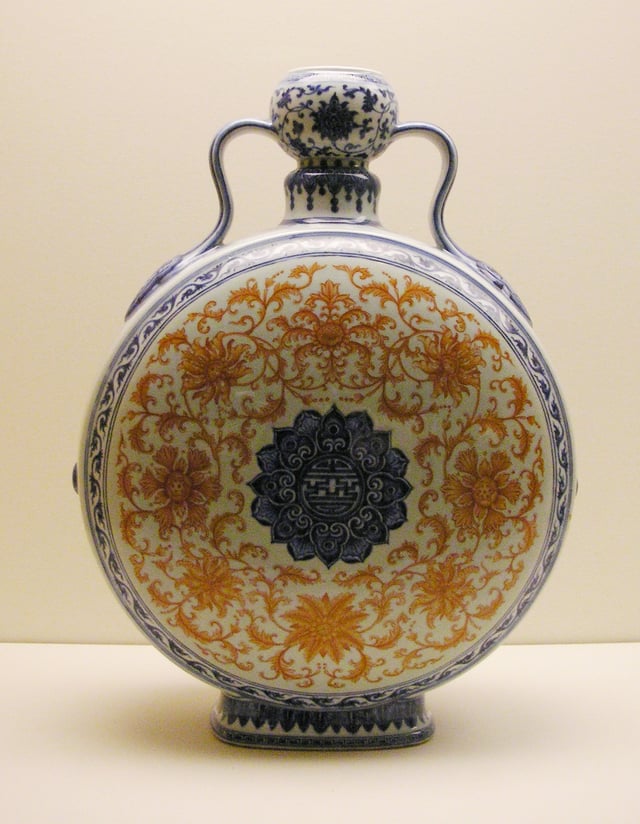
Pilgrim flask, porcelain with underglaze blue and iron-red decoration. Qing dynasty, Qianlong period in the 18th century.
Perhaps the most important factor in the development of the second commercial revolution was the mass influx of silver that entered into the country from foreign trade. After the Spanish conquered the Philippines in the 1570s they mined for silver around the New World, greatly expanding the circulating supply of silver. Foreign trade stimulated the ubiquity of the silver standard, after the re-opening of the southeast coast, which had been closed in the late 17th century, foreign trade was quickly re-established, and was expanding at 4% per annum throughout the latter part of the 18th century.[176] China continued to export tea, silk and manufactures, creating a large, favorable trade balance with the West.[169] The resulting inflow of silver expanded the money supply, facilitating the growth of competitive and stable markets.[177] During the mid-Ming China had gradually shifted to silver as the standard currency for large scale transactions and by the late Kangxi reign the assessment and collection of the land tax was done in silver. By standardizing the collection of the land tax in silver, landlords followed suit and began only accepting rent payments in silver rather than in crops themselves, which in turn incentivized farmers to produce crops for sale in local and national markets rather than for their own personal consumption or barter.[156] Unlike the copper coins, qian or cash, used mainly for smaller peasant transactions, silver was not properly minted into a coin but rather was traded in designated units of weight: the liang or tael, which equaled roughly 1.3 ounces of silver. Since it was never properly minted, a third-party had to be brought in to assess the weight and purity of the silver, resulting in an extra "meltage fee" added on to the price of transaction. Furthermore, since the "meltage fee" was unregulated until the reign of the Yongzheng emperor it was the source of much corruption at each level of the bureaucracy. The Yongzheng emperor cracked down on the corrupt "meltage fees," legalizing and regulating them so that they could be collected as a tax, "returning meltage fees to the public coffer." From this newly increased public coffer, the Yongzheng emperor increased the salaries of the officials who collected them, further legitimizing silver as the standard currency of the Qing economy.[175]
Urbanization and the proliferation of market-towns
The second commercial revolution also had a profound effect on the dispersion of the Qing populace. Up until the late Ming there existed a stark contrast between the rural countryside and city metropoles and very few mid-sized cities existed. This was due to the fact that extraction of surplus crops from the countryside was traditionally done by the state and not commercial organizations. However, as commercialization expanded exponentially in the late-Ming and early-Qing, mid-sized cities began popping up to direct the flow of domestic, commercial trade. Some towns of this nature had such a large volume of trade and merchants flowing through them that they developed into full-fledged market-towns. Some of these more active market-towns even developed into small-cities and became home to the new rising merchant-class.[156] The proliferation of these mid-sized cities was only made possible by advancements in long-distance transportation and methods of communication. As more and more Chinese-citizens were travelling the country conducting trade they increasingly found themselves in a far-away place needing a place to stay, in response the market saw the expansion of guild halls to house these merchants.[175]
Emergence of guild halls
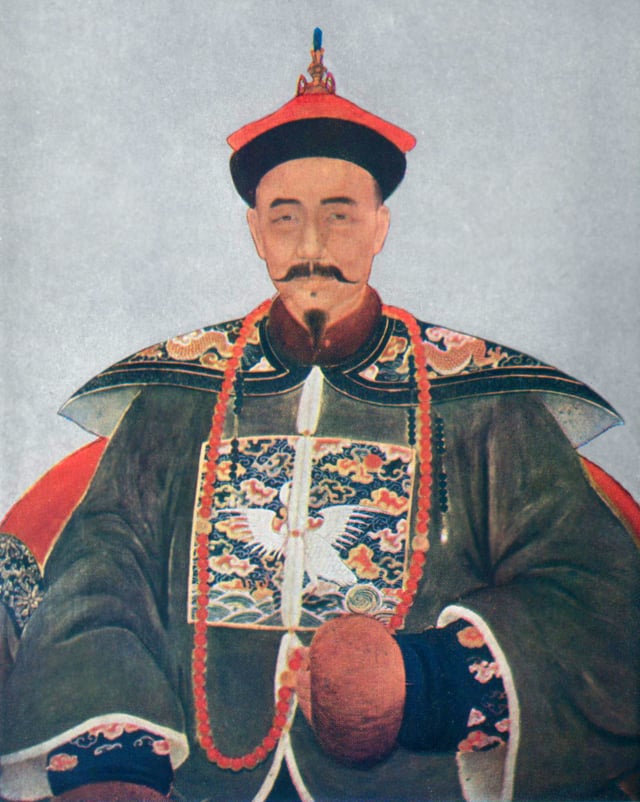
Puankhequa (Chinese: 潘启官; pinyin: Pān Qǐguān), also known as Pan Wenyan or Zhencheng (1714 – 10 January 1788), was a Chinese merchant and member of a Cohong family, which traded with the Europeans in Canton. This portrait from the 1700s is in the collections of the Gothenburg Museum.
A key distinguishing feature of the Qing economy was the emergence of guild halls around the nation. As inter-regional trade and travel became ever more common during the Qing, guild halls dedicated to facilitating commerce, huiguan, gained prominence around the urban landscape. The location where two merchants would meet to exchange commodities was usually mediated by a third-party broker who served a variety of roles for the market and local citizenry including bringing together buyers and sellers, guaranteeing the good faith of both parties, standardizing the weights, measurements, and procedures of the two parties, collecting tax for the government, and operating inns and warehouses.[156] It was these broker's and their places of commerce that were expanded during the Qing into full-fledged trade guilds, which, among other things, issued regulatory codes and price schedules, and provided a place for travelling merchants to stay and conduct their business. The first recorded trade guild set up to facilitate inter-regional commerce was in Hankou in 1656. Along with the huiguan trade guilds, guild halls dedicated to more specific professions, gongsuo, began to appear and to control commercial craft or artisanal industries such as carpentry, weaving, banking, and medicine.[155] By the nineteenth century guild halls had much more impact on the local communities than simply facilitating trade, they transformed urban areas into cosmopolitan, multi-cultural hubs, staged theatre performances open to general public, developed real estate by pooling funds together in the style of a trust, and some even facilitated the development of social services such as maintaining streets, water supply, and sewage facilities.[156]
Trade with the West
In 1685 the Kangxi emperor legalized private maritime trade along the coast, establishing a series of customs stations in major port cities. The customs station at Canton became by far the most active in foreign trade and by the late Kangxi reign more than forty mercantile houses specializing in trade with the West had appeared. The Yongzheng emperor made a parent corporation comprising those forty individual houses in 1725 known as the Cohong system. Firmly established by 1757, the Canton Cohong was an association of thirteen business firms that had been awarded exclusive rights to conduct trade with Western merchants in Canton. Until its abolition after the Opium War in 1842, the Canton Cohong system was the only permitted avenue of Western trade into China, and thus became a booming hub of international trade by the early eighteenth century.[155] By the eighteenth century the most significant export China had was tea. British demand for tea increased exponentially up until they figured out how to grow it for themselves in the hills of northern India in the 1880s. By the end of the eighteenth century tea exports going through the Canton Cohong system amounted to one-tenth of the revenue from taxes collected from the British and nearly the entire revenue of the British East India Company and until the early nineteenth century tea comprised ninety percent of exports leaving Canton.[175]
Science and technology
Chinese scholars, court academies, and local officials carried on late Ming dynasty strengths in astronomy, mathematics, and geography, as well as technologies in ceramics, metallurgy,water transport, printing. Contrary to stereotypes in some Western writing, 16th and 17th century Qing dynasty officials and literati eagerly explored the technology and science introduced by Jesuit missionaries. Manchu leaders employed Jesuits to use cannon and gunpowder to great effect in the conquest of China, and the court sponsored their research in astronomy. The aim of these efforts, however, was to reform and improve inherited science and technology, not to replace it.[178]
Scientific knowledge advanced during the Qing, but there was not a change in the way this knowledge was organized or the way scientific evidence was defined or its truth tested. The powerful official Ruan Yuan at the end of the eighteenth and early nineteenth centuries, for instance, suported a community of scientists and compiled the Chouren zhuan (畴人传; Biographies of mathematical scientists), a collection of biographies that eventually included nearly 700 Chinese and over 200 Western scientists. His attempt to reconcile Chinese and the Western science introduced by the Jesuits by arguing that both had originated in ancient China did not succeed, but he did show that science could be conceived and practiced separately from humanistic scholarship. Those who studied the physical universe shared their findings with each other and identified themselves as men of science, but they did not have a separate and independent professional role with its own training and advancement. They were still literati.[179]
The Opium Wars, however, demonstrated the power of the recently developed steam engine and military technology. The introduction of railroads raised questions that were more political than technological. Court officials feared railways would help invaders, harm farmlands and obstruct feng shui. The Shanghai—Woosung line completed by the British in 1876 was 12 miles long, but was torn up, partly because of bureaucratic rivalry, but mainly because officials did not want foreign control.[180] To keep development in Chinese hands, the Qing government borrowed 34 billion taels of silver from foreign lenders for railway construction between 1894 and 1911. As late as 1900, only 292 miles were in operation, with 4000 more miles in the planning stage. Finally, 5,200 miles of railway were completed. The British and French After 1905 were finally able to open lines to Burma and Vietnam.[181]
Protestant missionaries by the 1830s translated and printed Western science and medical textbooks. The textbooks found homes in the rapidly enlarging network of missionary schools, and universities. The textbooks opened learning open possibilities for the small number of Chinese students interested in science, and a very small number interested in technology. After 1900, Japan had a greater role in bringing modern science and technology to Chinese audiences but even then they reached chiefly the children of the rich landowning gentry, who seldom engaged in industrial careers.[182]
Arts and culture

A Daoguang period Peking glass vase. The vase is colored in "Imperial Yellow", which was popular due to its association with the Qing imperial dynasty.

A painting showing the daily life of a family of the officials in the Qing Dynasty
Under the Qing, inherited forms of art flourished and innovations occurred at many levels and in many types. High levels of literacy, a successful publishing industry, prosperous cities, and the Confucian emphasis on cultivation all fed a lively and creative set of cultural fields.
By the end of the nineteenth century, national artistic and cultural worlds had begun to come to terms with the cosmopolitan culture of the West and Japan. The decision to stay within old forms or welcome Western models was now a conscious choice rather than an unchallenged acceptance of tradition. Classically trained Confucian scholars such as Liang Qichao and Wang Guowei read widely and broke aesthetic and critical ground later cultivated in the New Culture Movement.
Fine arts
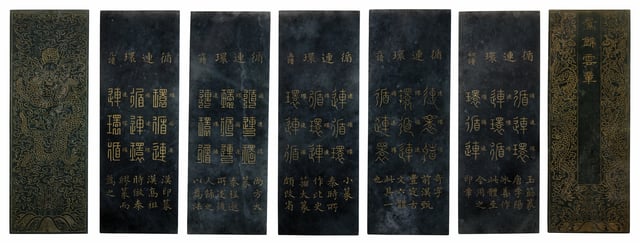
Jade book of the Qianlong period on display at the British Museum
The Qing emperors were generally adept at poetry and often skilled in painting, and offered their patronage to Confucian culture. The Kangxi and Qianlong Emperors, for instance, embraced Chinese traditions both to control them and to proclaim their own legitimacy. The Kangxi Emperor sponsored the Peiwen Yunfu, a rhyme dictionary published in 1711, and the Kangxi Dictionary published in 1716, which remains to this day an authoritative reference. The Qianlong Emperor sponsored the largest collection of writings in Chinese history, the Siku Quanshu, completed in 1782. Court painters made new versions of the Song masterpiece, Zhang Zeduan's Along the River During the Qingming Festival whose depiction of a prosperous and happy realm demonstrated the beneficence of the emperor. The emperors undertook tours of the south and commissioned monumental scrolls to depict the grandeur of the occasion.[183] Imperial patronage also encouraged the industrial production of ceramics and Chinese export porcelain. Peking glassware became popular after European glass making processes were introduced by Jesuits to Beijing.[184][185]
Yet the most impressive aesthetic works were done among the scholars and urban elite. Calligraphy and painting[186] remained a central interest to both court painters and scholar-gentry who considered the Four Arts part of their cultural identity and social standing.[187] The painting of the early years of the dynasty included such painters as the orthodox Four Wangs and the individualists Bada Shanren (1626–1705) and Shitao (1641–1707). The nineteenth century saw such innovations as the Shanghai School and the Lingnan School[188] which used the technical skills of tradition to set the stage for modern painting.
Traditional learning and literature
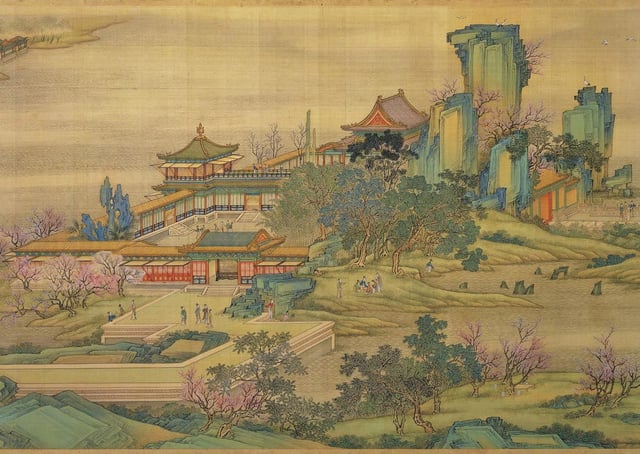
A scene of the "Qing Palace version" of the Along the River During the Qingming Festival, an 18th-century remake of the 12th century original

Landscape by Wang Gai, 1694
Traditional learning flourished, especially among Ming loyalists such as Dai Zhen and Gu Yanwu, but scholars in the school of evidential learning made innovations in skeptical textual scholarship. Scholar-bureaucrats, including Lin Zexu and Wei Yuan, developed a school of practical statecraft which rooted bureaucratic reform and restructuring in classical philosophy.
Literature grew to new heights in the Qing period. Poetry continued as a mark of the cultivated gentleman, but women wrote in larger and larger numbers and poets came from all walks of life. The poetry of the Qing dynasty is a lively field of research, being studied (along with the poetry of the Ming dynasty) for its association with Chinese opera, developmental trends of Classical Chinese poetry, the transition to a greater role for vernacular language, and for poetry by women in Chinese culture. The Qing dynasty was a period of much literary collection and criticism, and many of the modern popular versions of Classical Chinese poems were transmitted through Qing dynasty anthologies, such as the Quan Tangshi and the Three Hundred Tang Poems. Pu Songling brought the short story form to a new level in his Strange Stories from a Chinese Studio, published in the mid-18th century, and Shen Fu demonstrated the charm of the informal memoir in Six Chapters of a Floating Life, written in the early 19th century but published only in 1877. The art of the novel reached a pinnacle in Cao Xueqin's Dream of the Red Chamber, but its combination of social commentary and psychological insight were echoed in highly skilled novels such as Wu Jingzi's Rulin waishi (1750) and Li Ruzhen's Flowers in the Mirror (1827).[189]
In drama, Kong Shangren's Kunqu opera The Peach Blossom Fan, completed in 1699, portrayed the tragic downfall of the Ming dynasty in romantic terms. The most prestigious form became the so-called Peking opera, though local and folk opera were also widely popular.
Cuisine
Cuisine aroused a cultural pride in the richness of a long and varied past. The gentleman gourmet, such as Yuan Mei, applied aesthetic standards to the art of cooking, eating, and appreciation of tea at a time when New World crops and products entered everyday life. Yuan's Suiyuan Shidan expounded culinary aesthetics and theory, along with a range of recipes. The Manchu Han Imperial Feast originated at the court. Although this banquet was probably never common, it reflected an appreciation of Manchu culinary customs.[190] Nevertheless, culinary traditionalists such as Yuan Mei lambasted the opulence of the Manchu Han Feast. Yuan wrote that the feast was caused in part by the "vulgar habits of bad chefs" and that "displays this trite are useful only for welcoming new relations through one's gates or when the boss comes to visit". (皆惡廚陋習。只可用之於新親上門,上司入境)[191]
History and memory
Nationalism
Florian Schneider argues that, nationalism in China is largely a product of the digital revolution, in which a very large fraction of the population participates as readers and commentators And relators of ideas to their friends.[192][193] After 1911, writers, historians and scholars in China and abroad generally deprecated the failures of the late imperial system. However, in the 21st century, a highly favorable revisionism has emerged in the popular culture, in both the media and social media. Building pride in Chinese history, nationalists have portray Imperial China as benevolent, strong and more advanced than the West. They blame ugly wars and diplomatic controversies on imperialist exploitation by Western nations and Japan. Although officially still communist and Maoist, in practice China's rulers have used this grassroots settlement to proclaim their current policies are restoring China's historical glory.[194][195] Chairman Xi Jinping has, "sought nothing less than parity between Beijing and Washington--and promised to restore China to its historical glory."[196][197]
New Qing History
The New Qing History is a historiographical school that gained prominence in the United States in the mid-1990s by offering a wide-ranging revision of history of the Qing dynasty emphasizing the Manchus who ran it had a private agenda emphasizing multiculturalism, not Chinese nationalism.[198] Earlier historians had emphasized the power of Han Chinese to “sinicize” their conquerors, that is, to assimilate and make them Chinese in their thought and institutions. In the 1980s and early 1990s, American scholars began to learn Manchu and took advantage of newly opened Chinese- and Manchu-language documents in the archives. This research found that the Manchu rulers were savvy in manipulating their subjects and from the 1630s through at least the 18th century, emperors developed a sense of Manchu identity and used Central Asian models of rule as much as they did Confucian ones. According to the new school the Manchu ruling class regarded "China" as only a part, although a very important part, of a much wider empire that extended into the Inner Asian territories of Mongolia, Tibet, the Manchuria and Xinjiang (i.e. Chinese (Eastern) Turkestan.[199]
Some scholars, led by Ping-ti Ho criticize the nwq approach for exaggerating the Manchu character of the dynasty, and some in China accuse the American historians in the group of imposing American concerns with race and identity or even of imperialist misunderstanding to weaken China. Still others in China agree that this scholarship has opened new vistas for the study of Qing history.[200][201][202][203]
The use of "New Qing History" as an approach has no bearing on the New Qing History, a multi-volume history of the Qing dynasty that was authorized by the Chinese State Council in 2003.[204]
See also
Anti-Qing sentiment
Costumes of Qing officials
Eminent Chinese of the Ch'ing Period
Foreign relations of the Qing dynasty
History of rail transport in China
Imperial Chinese harem system
International relations of the Great Powers (1814–1919)
Islam during the Qing dynasty
List of emperors
List of Manchu clans
List of rebellions in China
List of recipients of tribute from China
List of rulers of China
Manchuria under Qing rule
Military history of China before 1911
Mongolia under Qing rule
Names of the Qing dynasty
New Qing History
Qing conquest theory
Qing dynasty coinage
Qing dynasty in Inner Asia
Qing emperors' family tree
Qing official headwear
Qing poetry
Royal and noble ranks of the Qing dynasty
Taiwan under Qing rule
The Rise and Fall of Qing Dynasty
Tibet under Qing rule
Timeline of Chinese history
Timeline of late anti-Qing rebellions
Women in Qing China
Xinjiang under Qing rule

